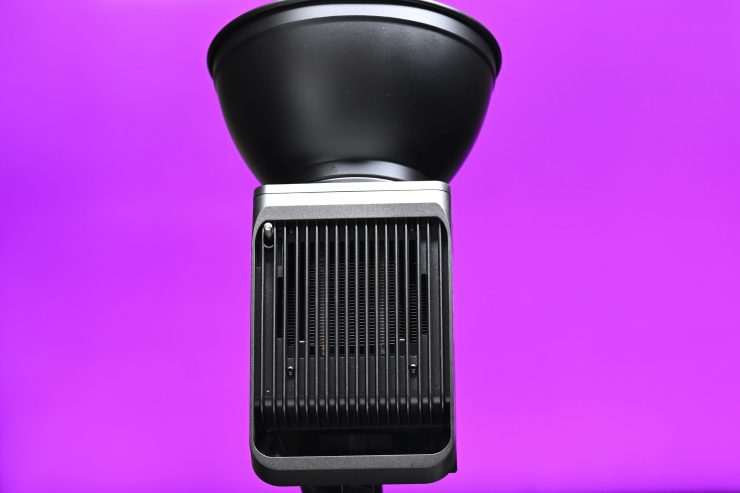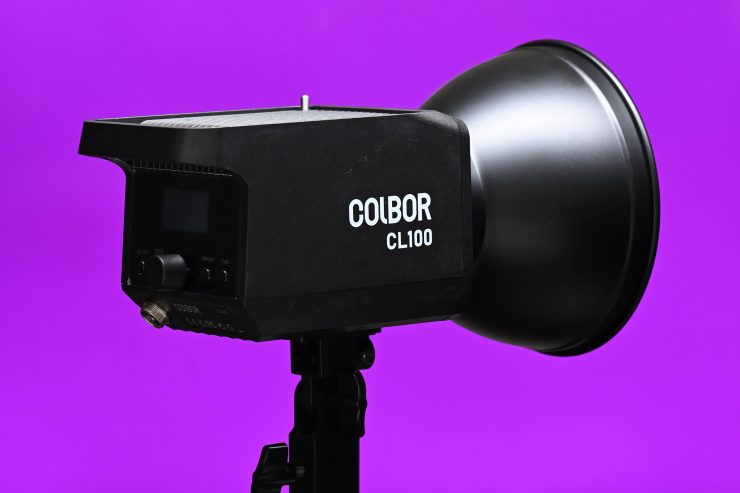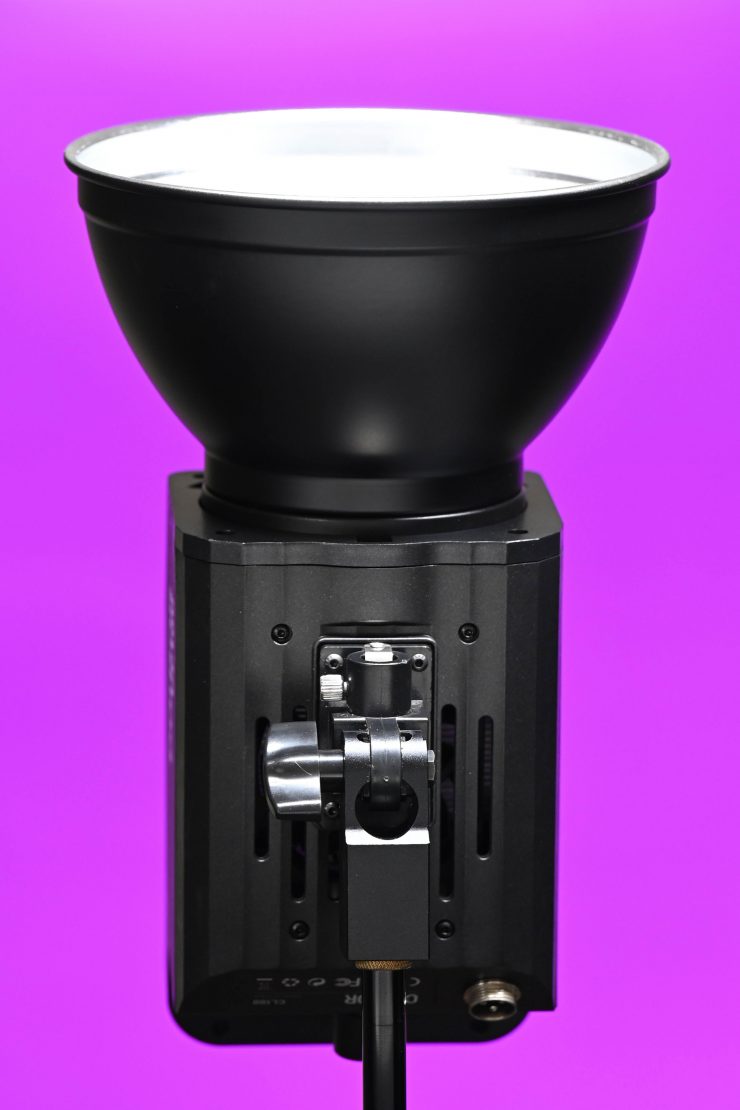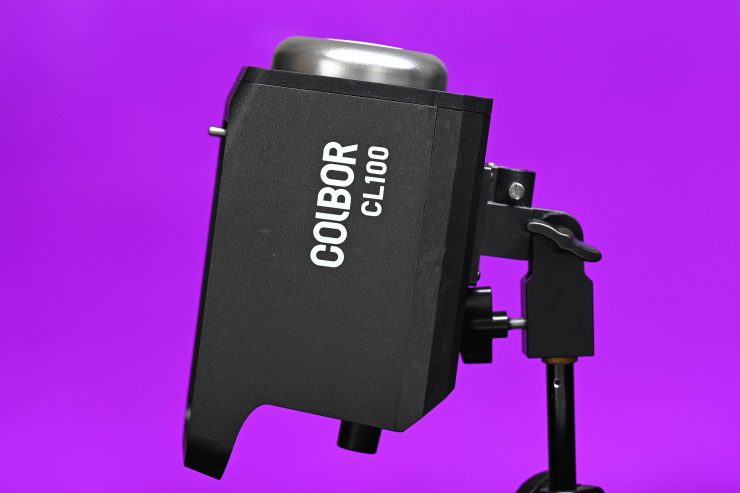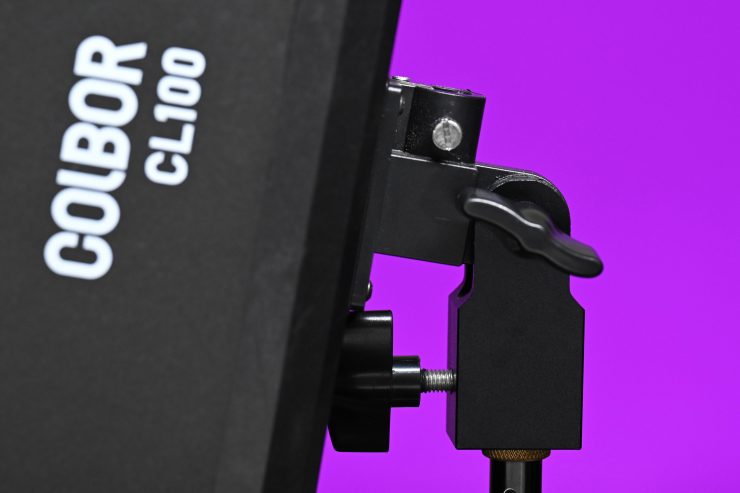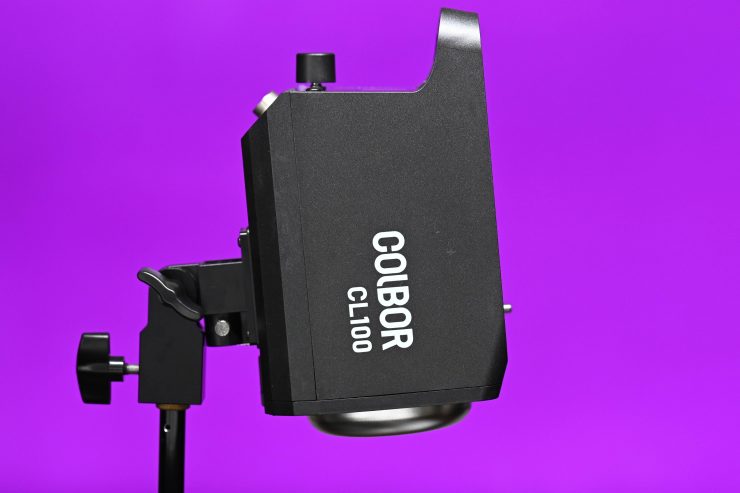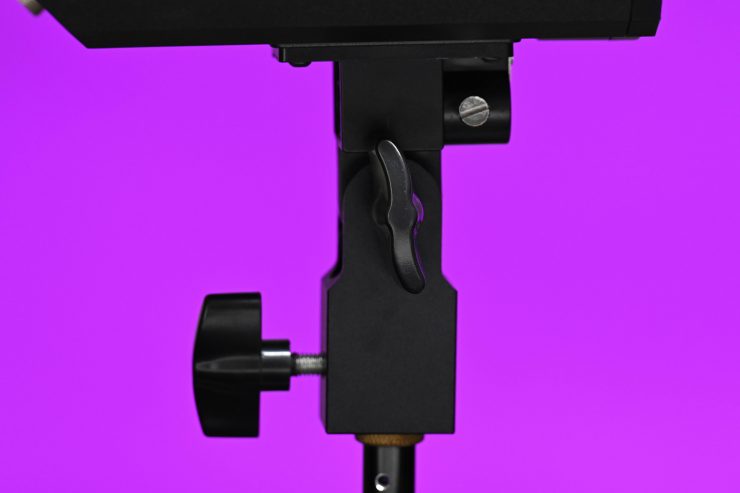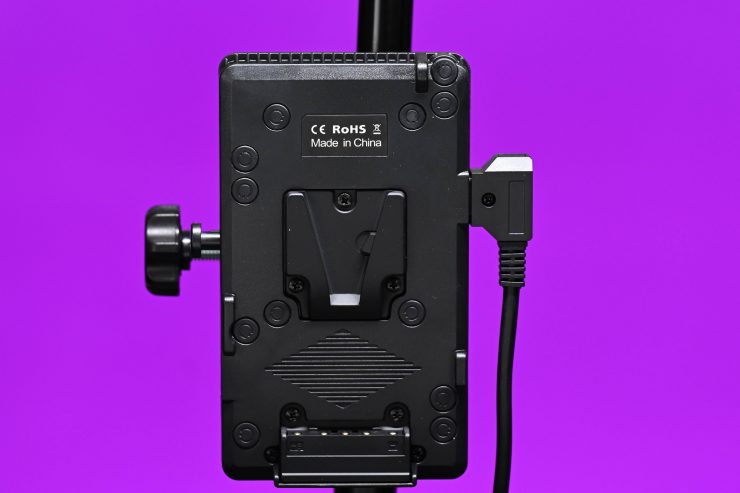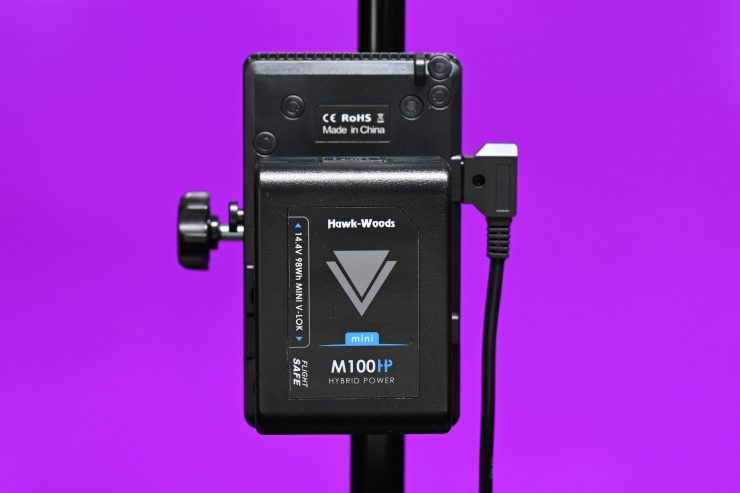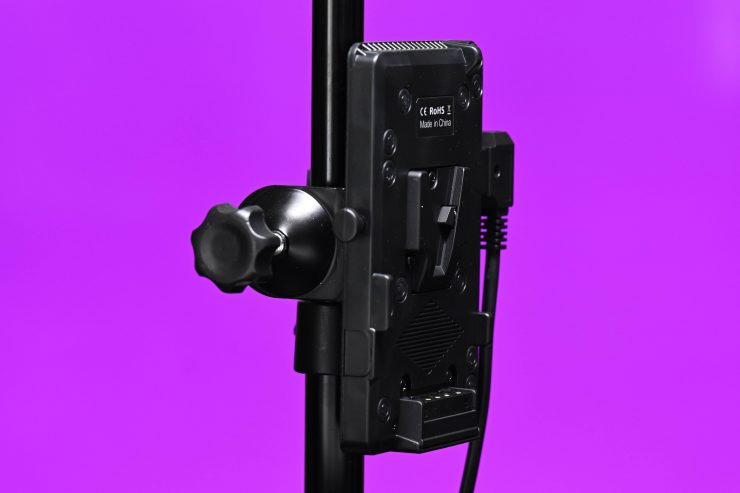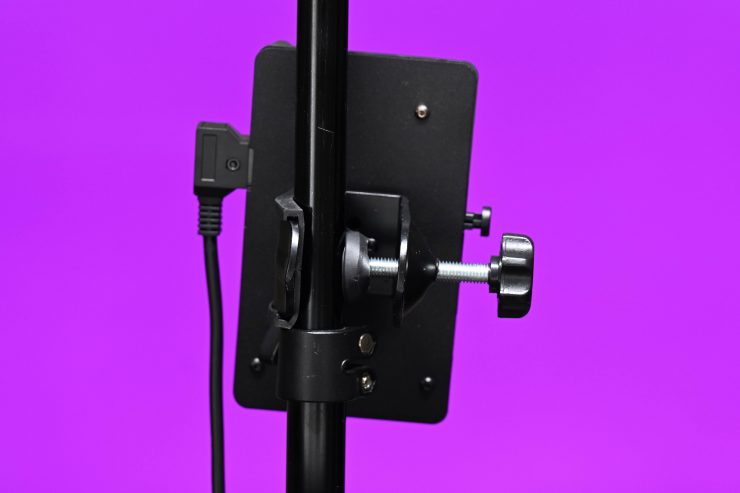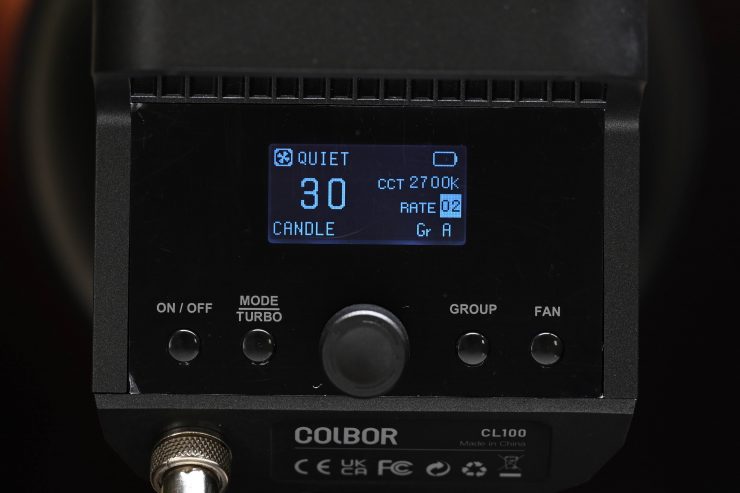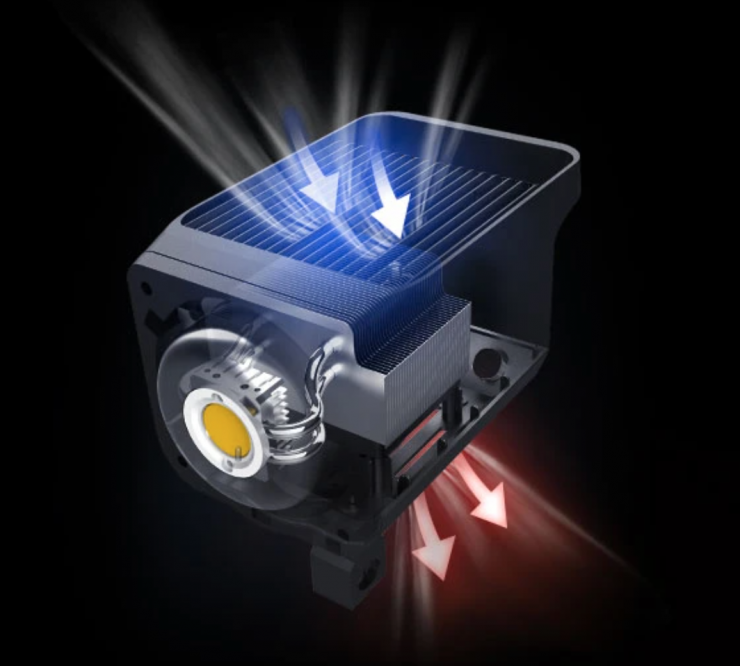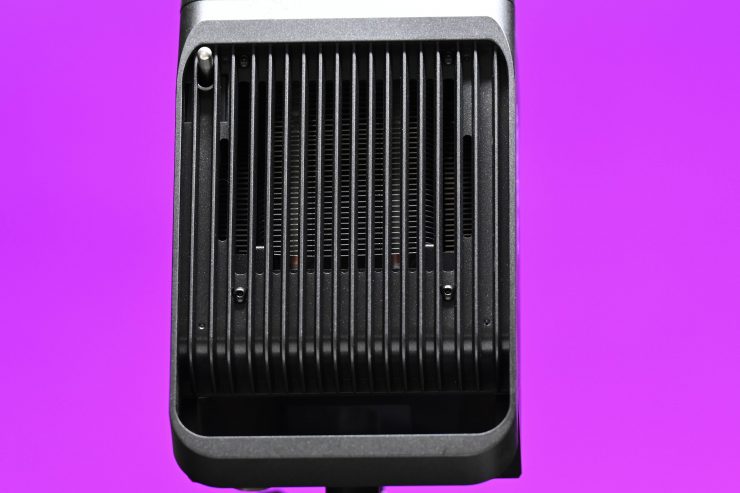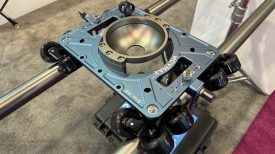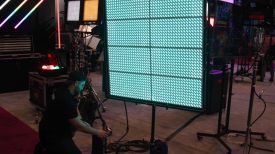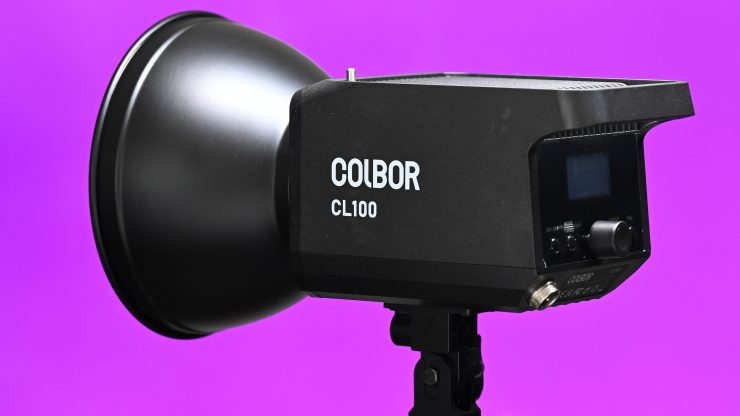
The COLBOR CL100 is a 100W Bi-Color COB LED light. It is similar to a lot of other COB-style lights that feature a Bowens-S Mount.
The light is Kelvin color adjustable from 2700-6500K and it can be run from a flight safe battery.
COB lights seem to be all the rage at the moment, and that is mainly due to their versatility. Having one fixture that you can use for a variety of lighting scenarios makes a lot of sense, especially for solo operators, small-sized crews, and anyone who needs to power a light remotely from a flight safe battery. I have reviewed a lot of lights in this form factor recently and I think this is because of their increasing popularity.
Key features
- Color: 2700-6500K
- CRI/TLCI: ≥ 97 (claimed)
- Dimming: 0-100%
- Beam Angle ≈∠ 120° (With Standard Cover 55°)
- FX Modes
- Wireless App Control
- Optional Remote Controller
- 100W Draw
- AC Adapter
On paper, the COLBOR CL100 looks to be a good budget lighting solution, so let’s find out how it actually performs.
Concept
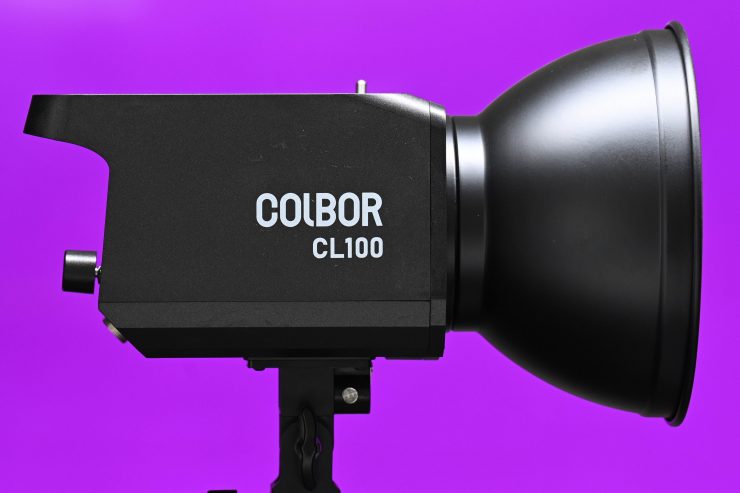
The concept for this light is pretty straightforward, make a versatile COB fixture that can be run via a flight safe battery that won’t empty your wallet. The only trouble with this concept is that there is already a ton of other similar style lights on the market from more well-known manufacturers. By no means should you ever discount a light from a manufacturer that you haven’t heard of before, but it does certainly make it harder to attract potential buyers.
Here at Newsshooter, every product gets reviewed in the same unbiased, independent way and nobody gets preferential treatment. The COLBOR CL100 Bi-Color will get reviewed in the same way as every other light I have ever reviewed.
Build Quality
The build quality of the COLBOR CL100 doesn’t inspire a ton of confidence. The housing is made out of lightweight ABS material, but it doesn’t seem that robust compared to other similar lights that I have reviewed. In saying that, it is a ‘budget friendly’ light so you can’t expect too much. To be fair to COLBOR, most budget lights at this price point don’t tend to have stellar build quality either.
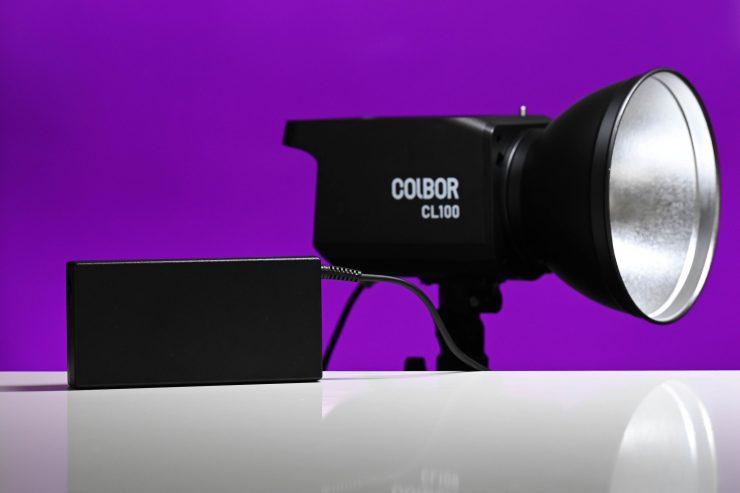
The controller is built into the light fixture, but there is a separate power supply. This is not overly small and COLBOR has included cables that are of a decent length.
The cable that goes to the power supply is long enough so that you can position your fixture around 200cm / 6.56′ high and still keep the power supply on the ground.
COLBOR doesn’t give you any way of attaching the power supply to a light stand as there is no hook or lanyard on it like you will find on some other lights.
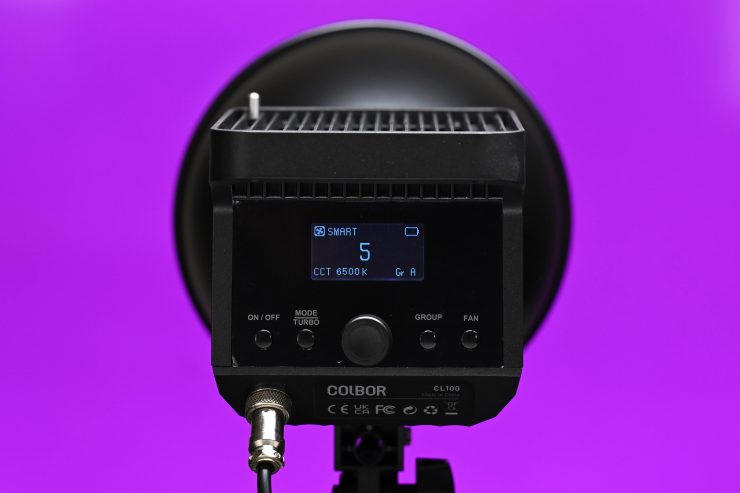
The dials and buttons on the fixture are reasonably tactile and easy enough to use.
Design
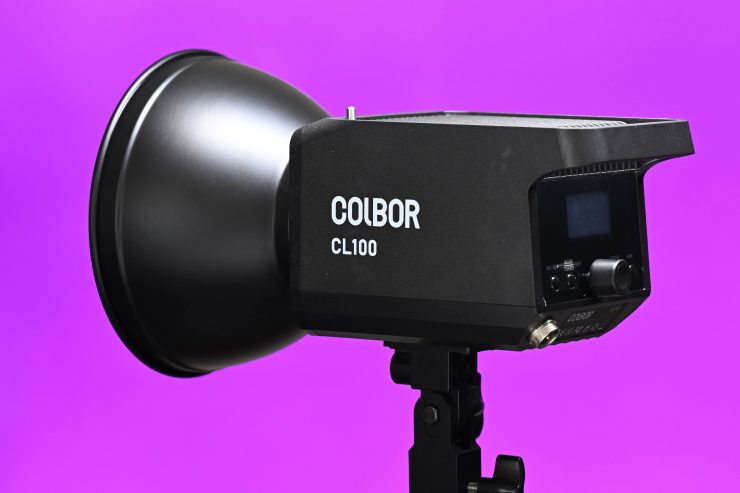
As far as the design goes, it does look reasonably similar to most other COB fixtures. It is essentially a rectangle with a COB on the front and modifier mount. The light certainly isn’t going to win any style or design awards.
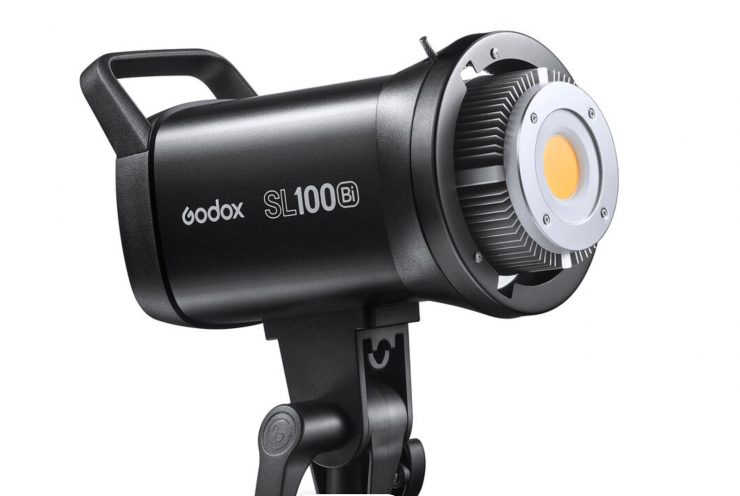
Design-wise it looks fairly similar to the Godox SL100Bi Bi-Color LED Video Light.
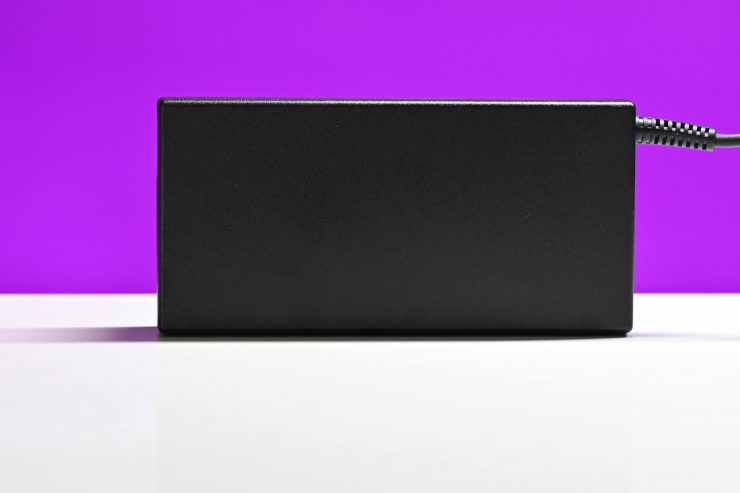
As I previously mentioned, the design consists of the lamp head and a separate power supply. This is fairly common with lights such as these. It is nice not to have a separate controller and have it built into the fixture. This allows you to set up and pack away the light quickly.
The power supply that comes with the light is pretty big.
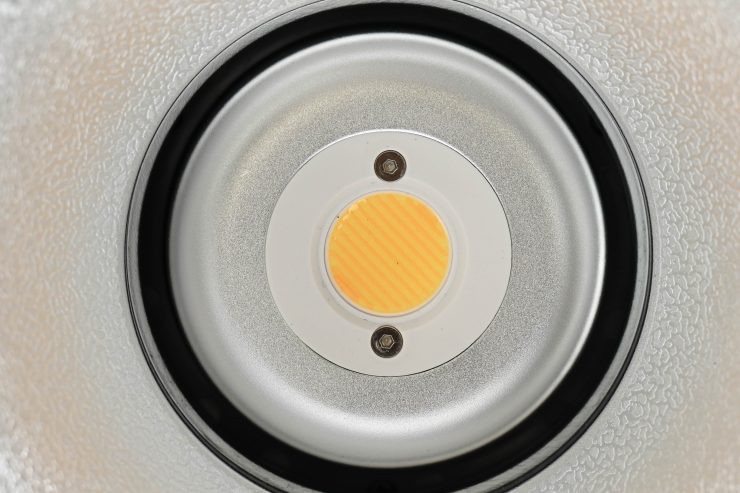
Lots of LED lights on the market, including the COLBOR CL100 are using COB technology. COB stands for “Chip On Board” where multiple LED chips are packaged together as one lighting module. The advantage of COB LEDs being multi-chip packaged is that the light-emitting area of a COB LED can contain many times more light sources in the same area that standard LEDs could occupy. This results in a greatly increased lumen output per square inch.
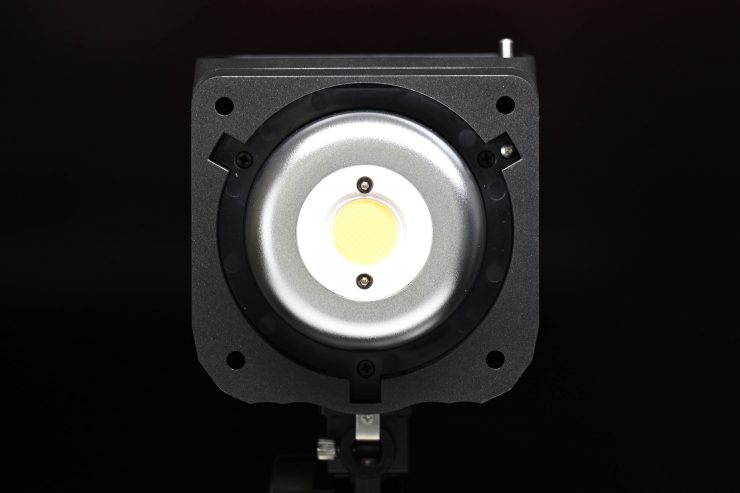
The biggest problem with COB LED lights is that unless you diffuse them they are very bright to look at and unsuitable for directly lighting talent. You need to clearly factor this in when judging how much output it has when used with the reflector.
Weight & Size
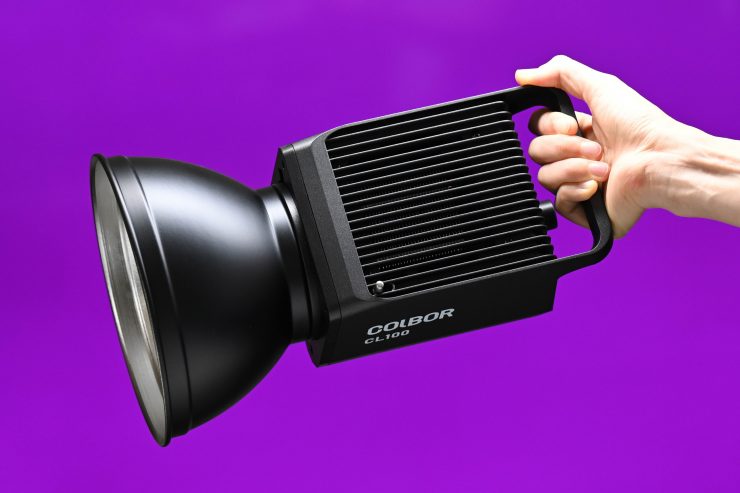
The COLBOR CL100 is made out of a lightweight ABS material and it tips the scales at 1.1kg / 2.43 lb. As I have already mentioned, the controller is built-in to the lamp head, there is just a separate AC adapter. The low weight means you can use it with lightweight light stands.
The fixture has dimensions of 20.2cm x 11.6cm x 11.7cm / 7.95″ x 4.56″ x 4.6″.
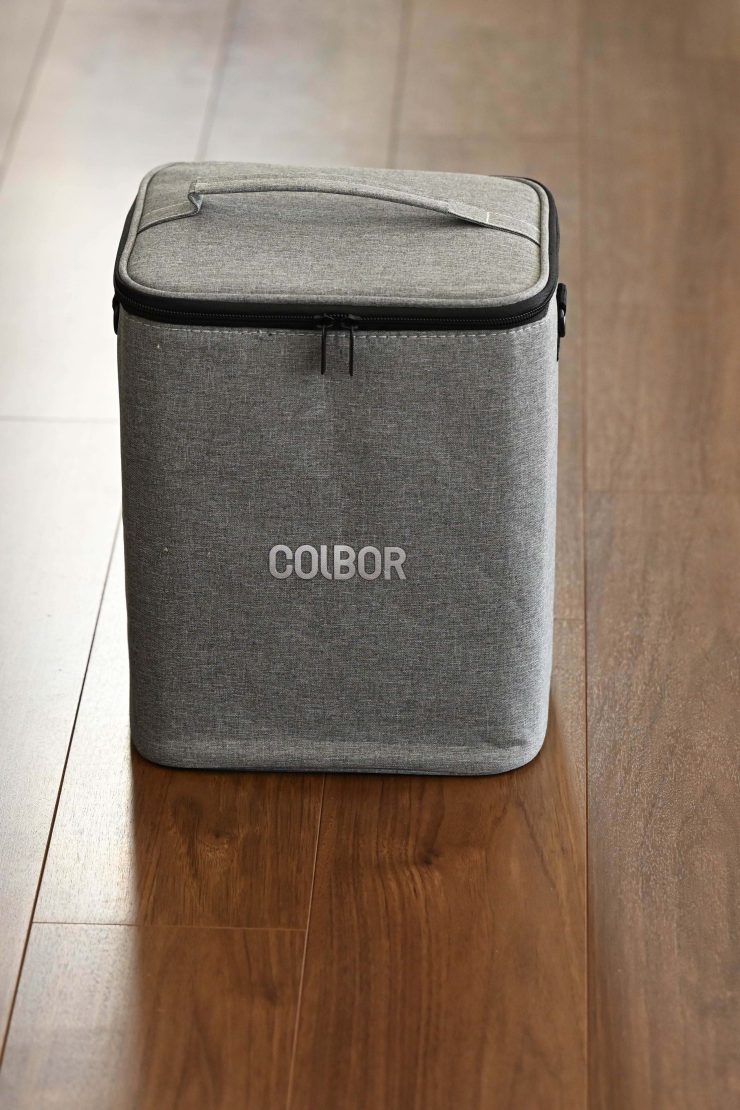
The light itself is reasonably compact, and it does come in a storage bag with all of the included accessories and power cables. This storage bag is pretty decent considering we are talking about a $200 USD light.
So how does the weight compare to some other similar fixtures?
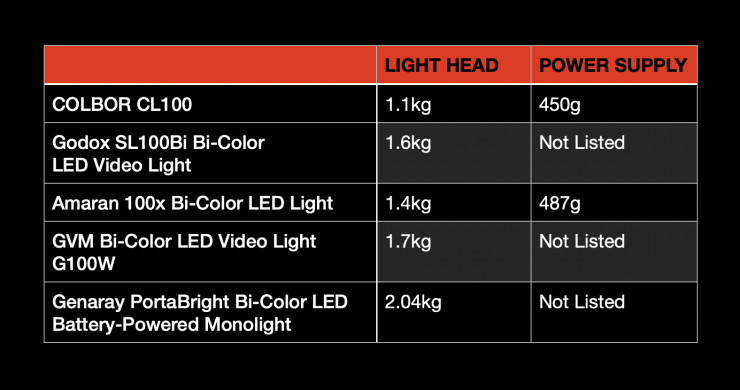
The COLBOR is lighter than most of the competition, but I think that is certainly reflected in its build quality.
Mounting
The COLBOR doesn’t come with a yoke frame, instead, it features a ratchet-style adjustable mount. This can be removed from the fixture if you undo four screws with an Allen key.
This mount is ok and it locks down securely. I am not the biggest fan of rachet-style arms for lights, but it gets the job done. I would have preferred to have seen a more robust metal mounting system being used.
The angle of rotation you can get when using the fixture is reasonably good.
If you put large-sized lighting modifiers on the front of the fixture it does become more difficult to lock off the adjustment knob. The light stand interface can just barely support a large-sized soft box and I would be concerned over time that it may well ultimately end up failing.
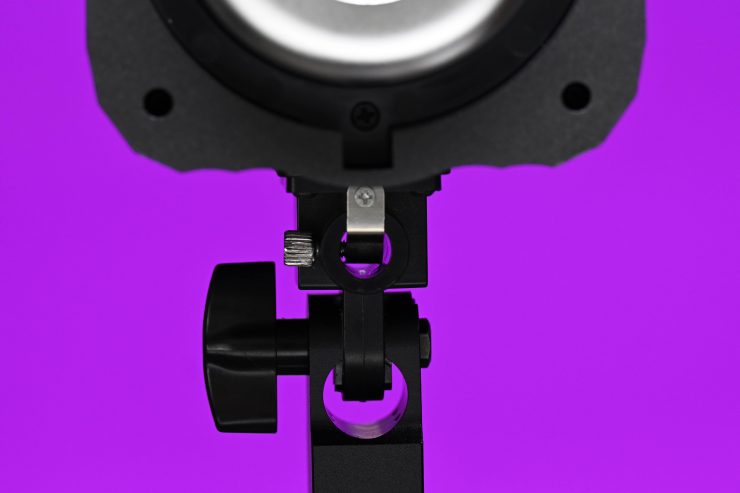
The mounting grip does have space to insert an umbrella if you wanted to use one.
Power Draw
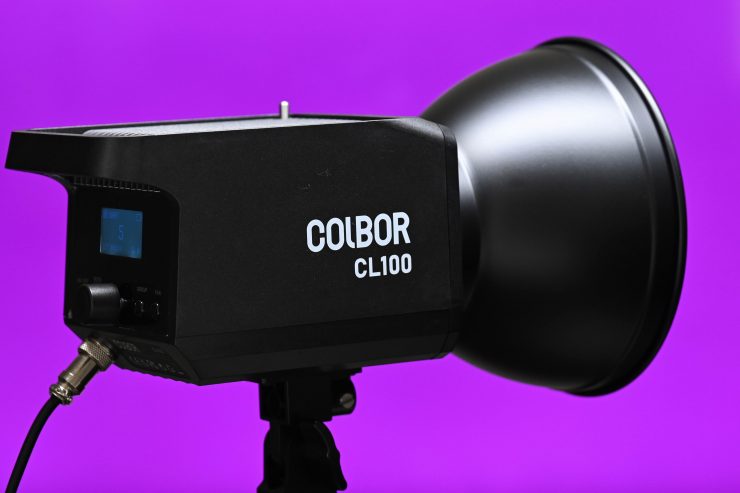
The COLBOR CL100 draws 100W so it is very easy to run the light remotely for long periods of time using flight safe batteries.
The light can be run using the AC adapter or via the optional V-lock battery plate.
The optional V-mount battery plate has to be attached to a light stand. This battery plate is well made and it features a D-tap outlet on the side of it in case you need to still power the light with a V-mount battery that doesn’t feature its own D-tap port.
It comes with a 60cm / 23.6″ long D-tap to 3-pin power cable.
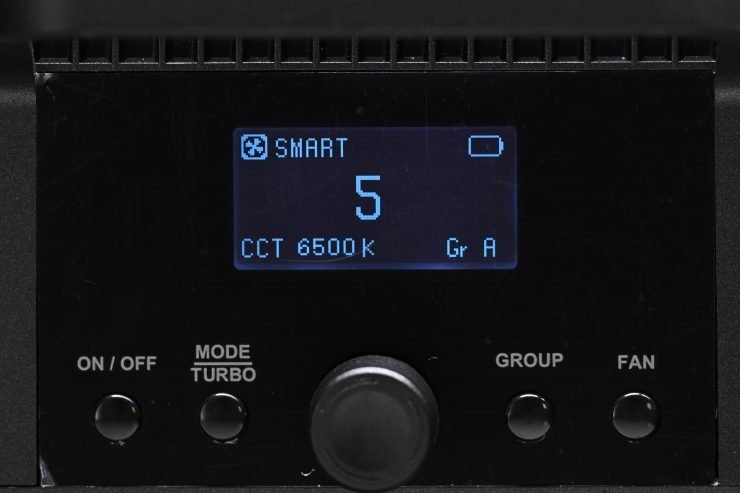
Now, the strange thing I noticed is that when you are running the light via a V-mount battery is that the battery icon on the LCD screen shows that the battery is empty. This is very confusing, to say the least.
It is also slightly strange that COLBOR went with a V-mount battery plate solution. A lot of people who are buying a $200 USD light are probably not going to own V-lock batteries. It probably would have made more sense to offer a battery plate that used dual Sony NP batteries.
Controls & Menu System
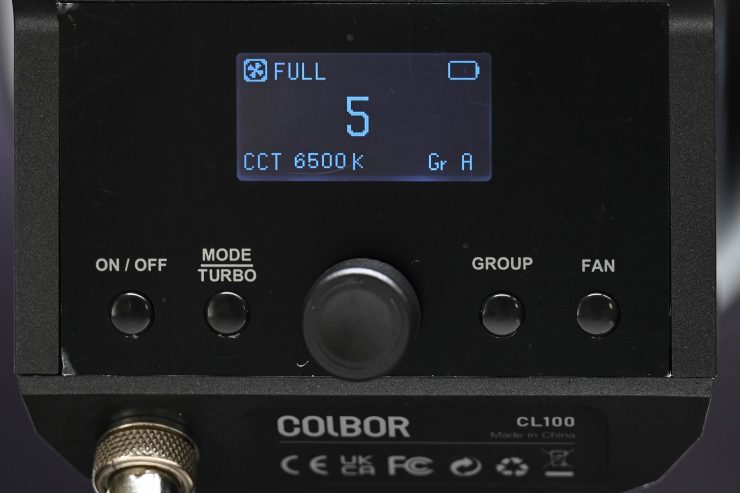
The rear LCD screen is very basic and it just shows you the light’s output intensity as a percentage, the Kelvin color temperature, the status of the fan, and a battery icon.
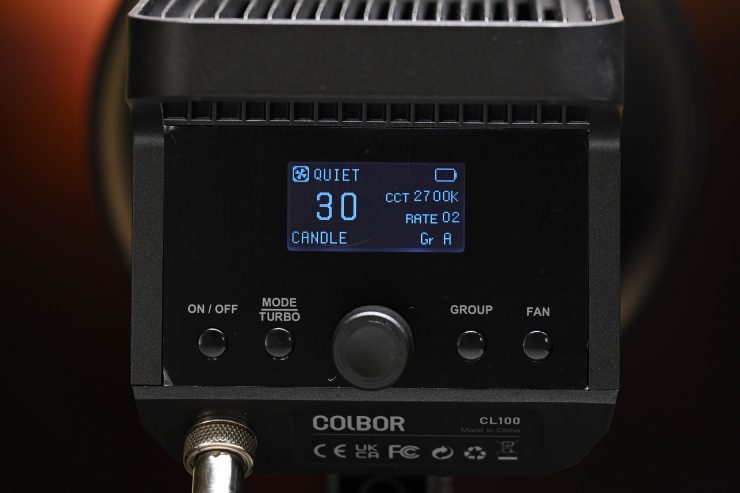
Certain elements shown on the display are all over the place. Look, is this really a huge deal? Well, that depends on the end-user. It personally bothers me because it shows a lack of attention to detail. Again, this is a ‘budget friendly’ light, so you are going to ultimately get what you pay for when it comes to build quality and attention to detail.
The actual brightness of the screen is very low and you can’t see it outdoors. Even indoors unless you have it at eye height and you are looking at it straight, you will struggle to see the screen.
You can only change the output percentage in 5% increments which is not ideal. The Kelvin color temperature can be adjusted in increments of 50K.
The menu is pretty basic, but you can adjust the fan, group, and the various FX modes that are included.
With a good light, you shouldn’t have to read a manual to work out how to operate it. You should be able to turn it on and use it straight away. In that respect, the light is fairly straightforward and easy to operate.
Remote Control
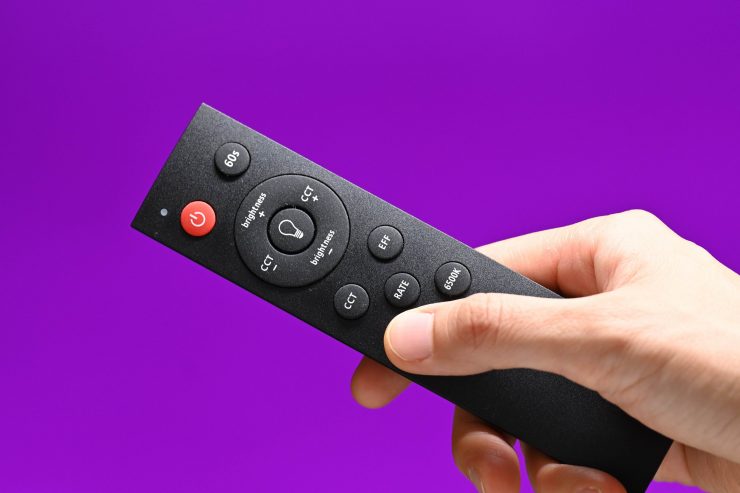
There is no way of controlling the light via an App. however, you can control it using the include remote controller.
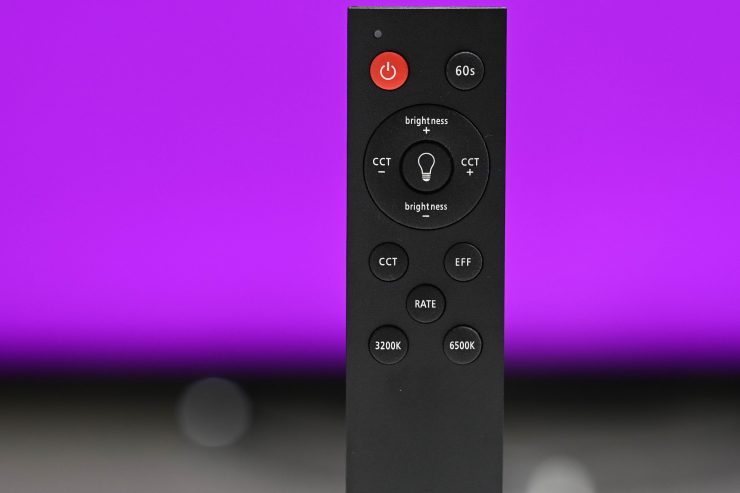
The remote controller is nicely designed and it reminds me of the original Apple TV remote.
The remote controller takes two AAA batteries, but COLBOR doesn’t include any with the kit. Now, it is a little tricky and overly complicated to pair the remote with the fixture. You have to disconnect the CL 100 from a power supply and then plug it back in and turn it on. Then you need to point the remote control at the fixture and long-press the EFF mode button on the remote control for three seconds. I tried doing this numerous times and I couldn’t get the remote controller to pair with the light.
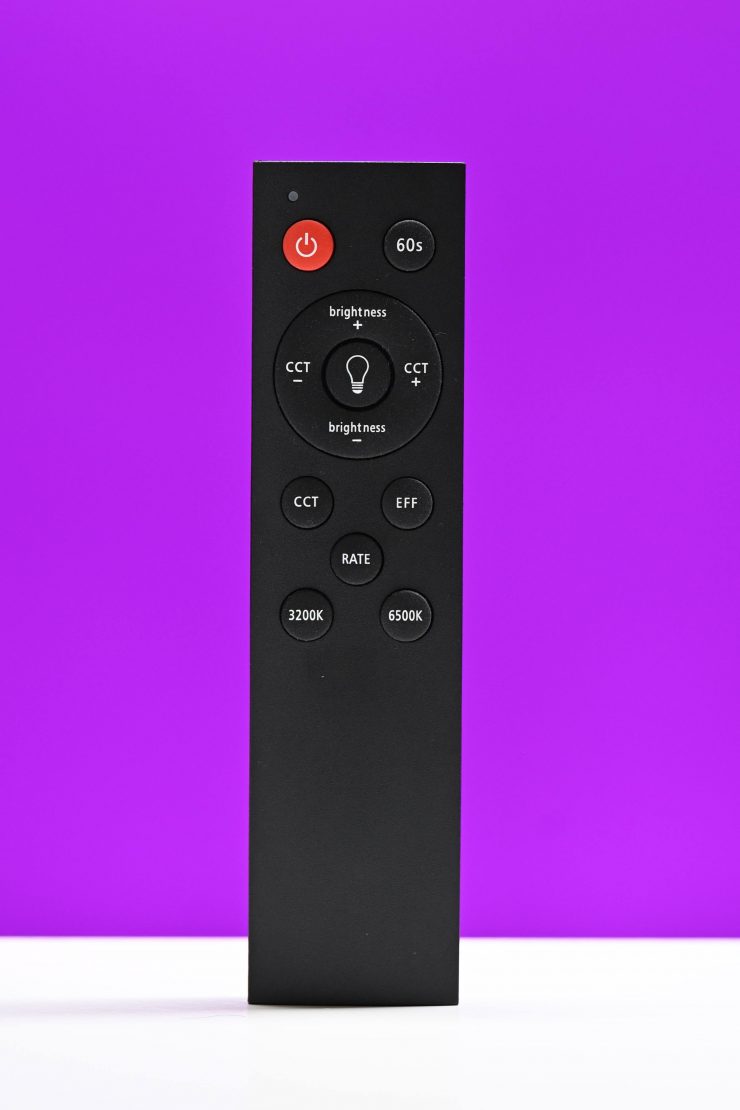
It turns out that the included instructions ARE COMPLETELY WRONG! What you actually have to do is to turn on the light and then long-press the 60s button on the remote controller until the light starts flashing. You then have to turn the light off, pull the power cable out of the light and then plug it back in, and then long-press the EFF button on the remote.
This whole pairing system is ridiculously complicated and not intuitive at all.
Once you have sorted out the complicated pairing procedure, the remote controller is very straightforward and easy to use. There is a range of parameters that you can adjust such as CCT, intensity, etc.
FX
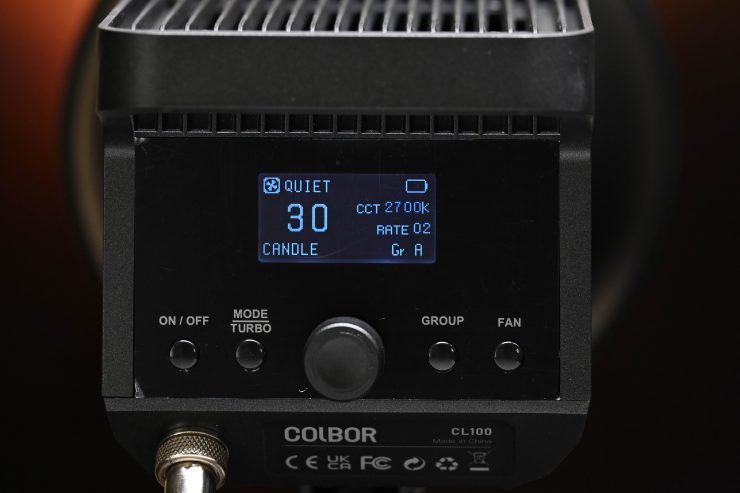
In the EFF (FX) mode, you can recreate 6 lighting effects that can be handy for certain scenarios. The effects are:
- Candle
- Bonfire
- BLN (Pulsing)
- Faulty Bulb
- Flash
- Lightning
You can adjust the intensity and the speed of the FX on the light fixture and the remote controller.
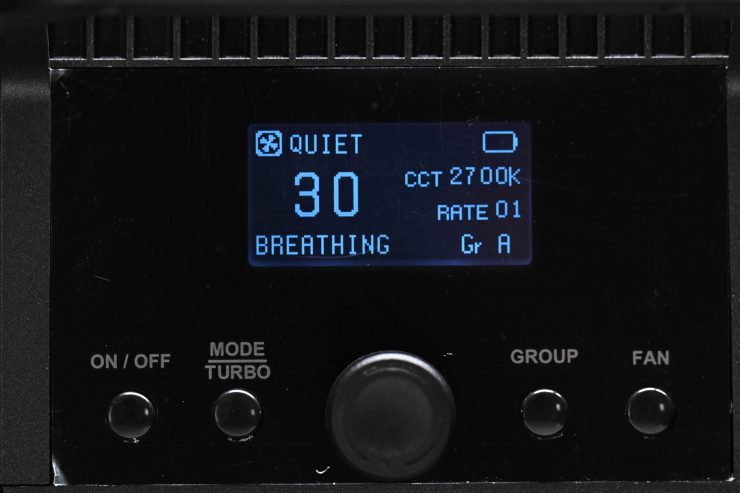
What is a little odd is that you can not adjust the intensity level when using the FX mode below 30%.
How does it stay cool?
High-powered COB lights get very hot, and keeping them cool is not an easy task. The COLBOR does feature an in-built fan. According to COLBOR the CL100 uses an intelligent temperature control system. It has several sensors to measure the working temperature in real-time. Once the preset temperature is reached, the internal fan will run to accelerate the air circulation and decrease the temperature. They also claim that the fixture features a unique fin and groove structure that allows for quicker heat dissipation.
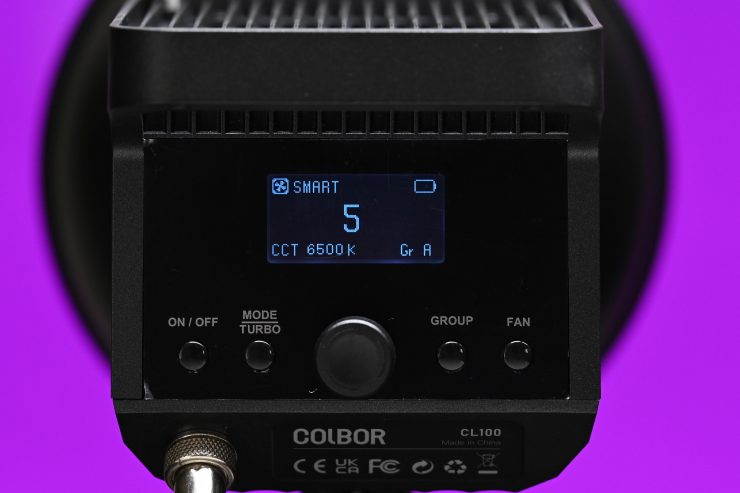
The in-built fan has three operating modes: SMART / QUIET/ FULL
SMART– The fixture will adjust the fan speed according to working temperature. This is the default mode.
QUIET– The fan is off. In order to protect the light, the power will be reduced to avoid overheating damage.
FUll– The fan is always on. This only comes on in the Overlock (Turbo Mode).
The fan in the light is reasonably quiet, but it does make a little bit of noise. Depending on what you are using the light for, this could be an issue, but in saying that, I think most people will be ok with it as long as it isn’t close to where audio will be recorded.
The biggest problem with fans such as these is you can be in the middle of an interview and suddenly the fan kicks in without warning. I also found that the noise of the fan seems to change at times when it is in the Smart Fan mode. I personally found that the QUIET fan mode was just a little bit too loud for my personal taste as it is louder than the SMART mode.
The fan does work well because the fixture doesn’t get overly hot when you are using it.
How does it compare to the Godox SL100Bi Bi-Color & Amaran 100x Bi-Color LED Light?
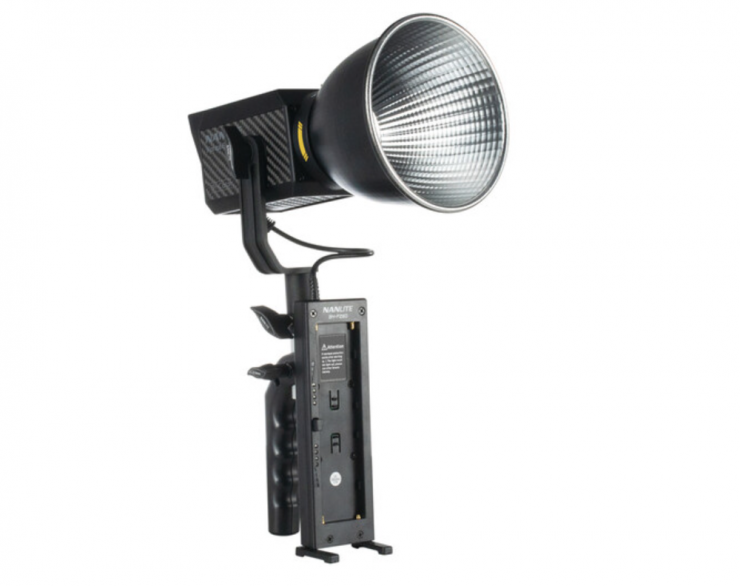
| COLBOR CL100 Bi-Color | Godox SL100Bi Bi-Color LED Video Light | |
| CCT Range | 2700-6500K | 2800-6500K |
| Effects | Yes | Yes |
| Mount | Bowens-S Mount | Bowens-S Mount |
| Power Draw | 100W | 100W |
| Claimed Output | 10,123lx @1m (6500K) With Standard Cover (claimed) | 32,100lx @ at 1 m (claimed) |
| App Control | Yes | Yes |
| Battery Plate | Yes | No |
| Weight | 1.1kg / 2.43 lb | 1.6 kg / 3.5 lb |
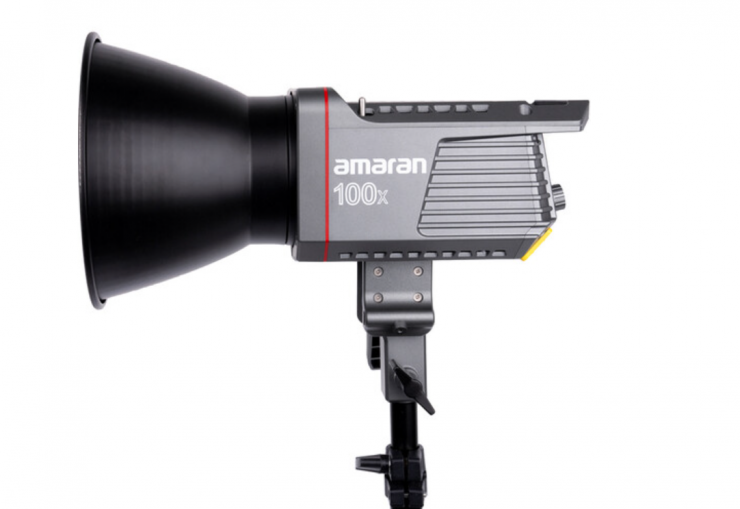
| COLBOR CL100 Bi-Color | Amaran 100x Bi-Color LED Light | |
| CCT Range | 2700-6500K | 2700-6500K |
| Effects | Yes | Yes |
| Mount | Bowens-S Mount | Bowens-S Mount |
| Power Draw | 100W | 100W |
| Claimed Output | 10,123lx @1m (6500K) With Standard Cover (claimed) | 34,300lx @ at 1 m (claimed) |
| App Control | Yes | Yes |
| Battery Plate | Yes | No |
| Weight | 1.1kg / 2.43 lb | 1.41 kg / 3.10 lb |
While the COLBOR CL100 Bi-Color has an almost identical feature set to both the Godox SL100Bi Bi-Color and Amaran 100x Bi-Color LED Lights, its claimed output is significantly lower.
Overlock mode
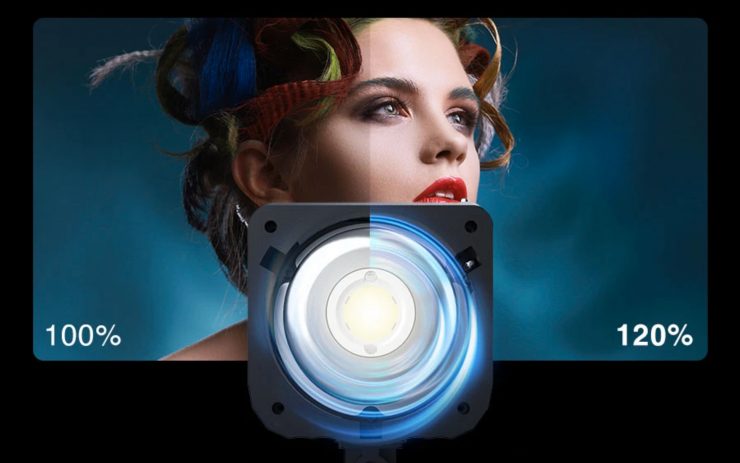
The light has what COLBOR refers to as an Overlock mode. In this mode, the output power is increased by 20%. Now, the caveat with this is that the light can only maintain this maximum brightness for up to 60 seconds.
This is a pretty strange mode to have, and I am not sure why you would include a mode that gives you 20% more output that can only be used for 60 seconds. Look, it is there if you need it, and some users may well find a use for it.
Photometrics
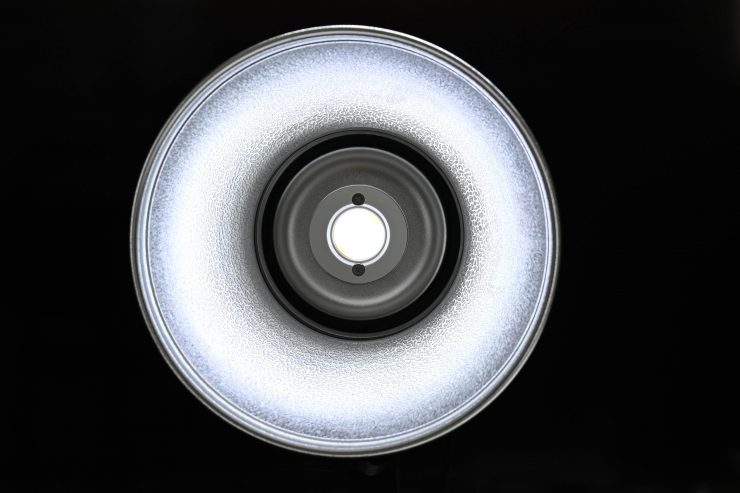
So now let’s get to the photometric results. I always test lights in this way so that I get a reference to how they compare to other fixtures. Results only tell part of the story and should never be used alone to judge a light. I have found from extensive testing over the years that certain lights that have good photometric results don’t always look good, and lights that have worse photometric scores can sometimes look better than their results indicate.
Different lights can also look different depending on what camera you happen to be using.
It is very important that you don’t judge a light based on one set of tests. You need to look at all of the photometric data to be able to evaluate a light correctly.
Output & Color Temperature Accuracy
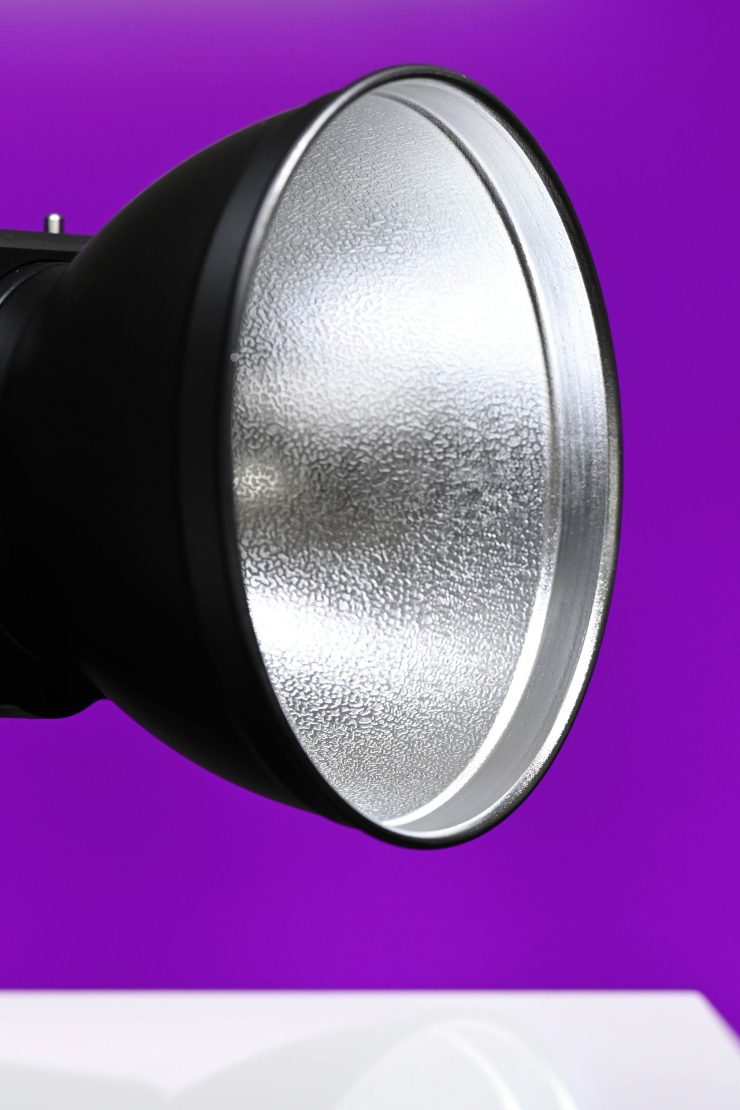
I tested the COLBOR CL100 Bi-Color at a variety of Kelvin color temperatures with a Sekonic C-800 Spectrometer to find out how much output the light had and how accurate the Kelvin color temperature reproduction was. All readings are taken at a distance of 1m (3.28ft) in a controlled environment.
Please note that my readings when using the reflector were taken 1m from the edge of the reflector and not the COB.
5600K
5600K (standard reflector 55°)
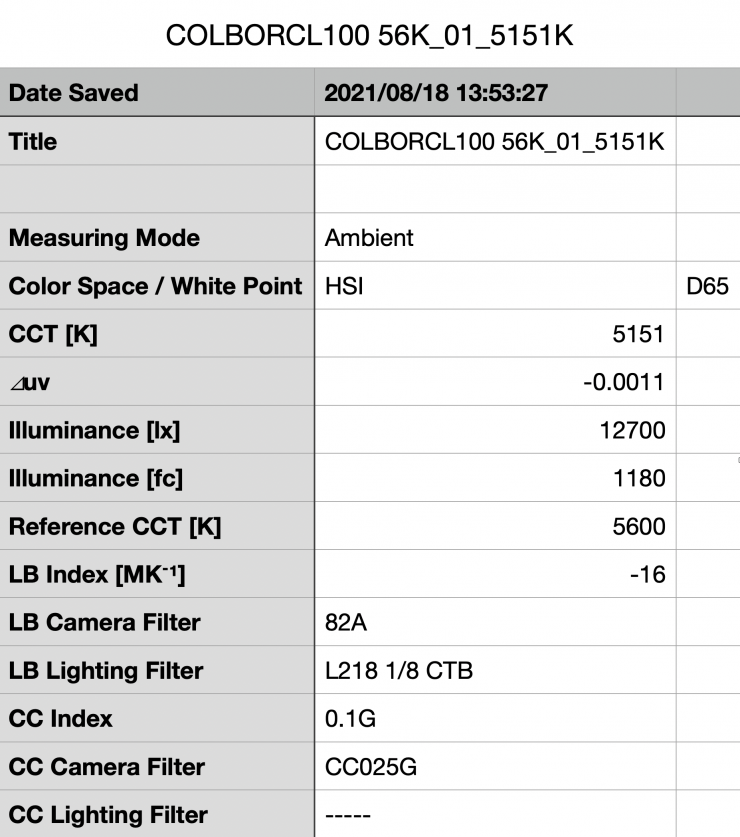
Above you can see the COLBOR recorded an output of 12700 lx (1180 fc) when set at 5600K using the standard reflector. This is not a ton of output for a 100W fixture.
As a comparison, the Godox ML60Bi LED Light puts out 11400 lx (1060 fc) when set at 5600K using the standard reflector. This light only draws 60W.
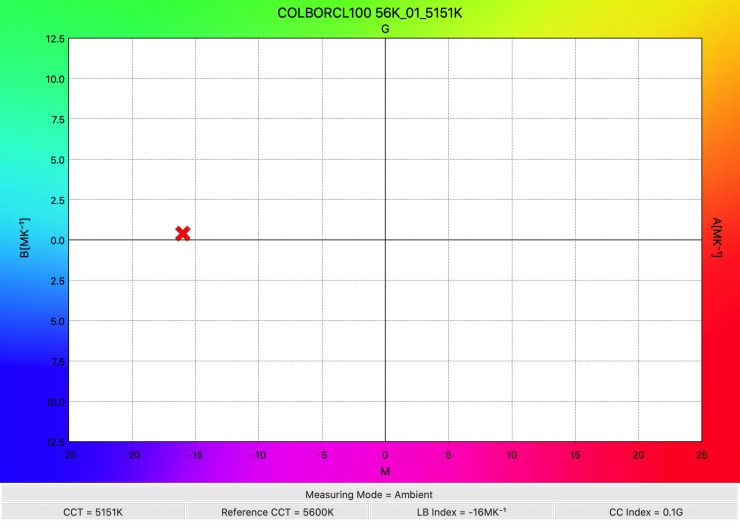
The light recorded a Kelvin color temperature reading of 5151K which was almost 350K off being accurate.
5600K (Turbo Mode)
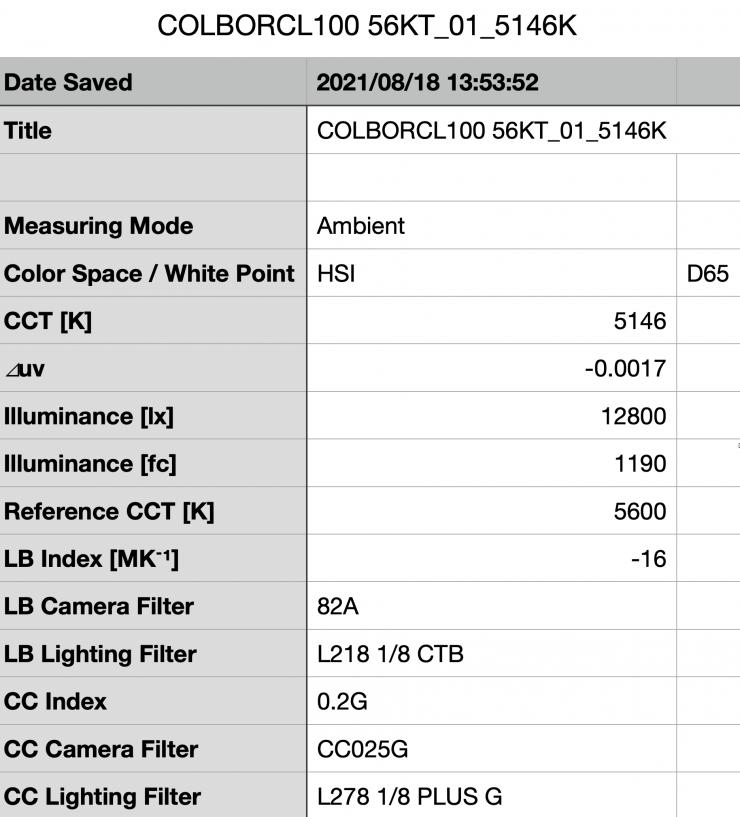
Above you can see the light’s output when it was set at 5600K with the standard reflector and set in the Turno mode was 12800 lx (1190 fc). COLBOR states that this mode is supposed to generate 20% more output than when the light is used in the regular mode. I found that the output only went up for 100 lx, or 0.78%.
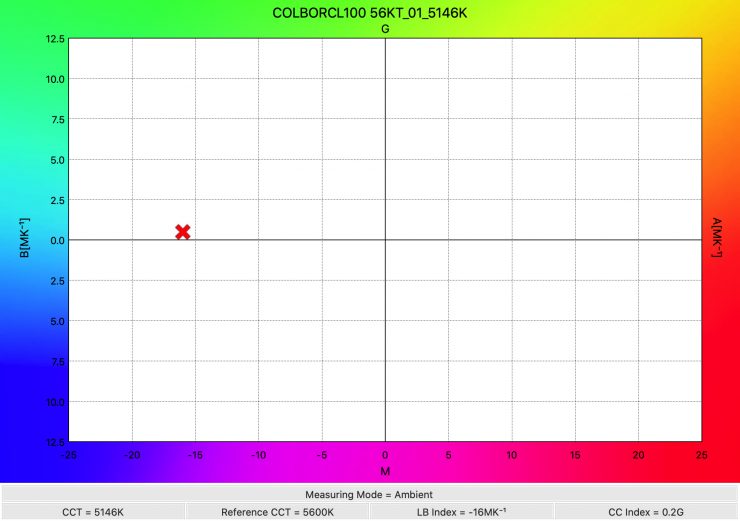
In this Turbo mode the light recorded a Kelvin color temperature of 5146, which was basically the same as when it was used in the normal mode. This shows me that the Turbo mode doesn’t alter the Kelvin color temperature accuracy.
3200K
3200K (standard reflector 55°)
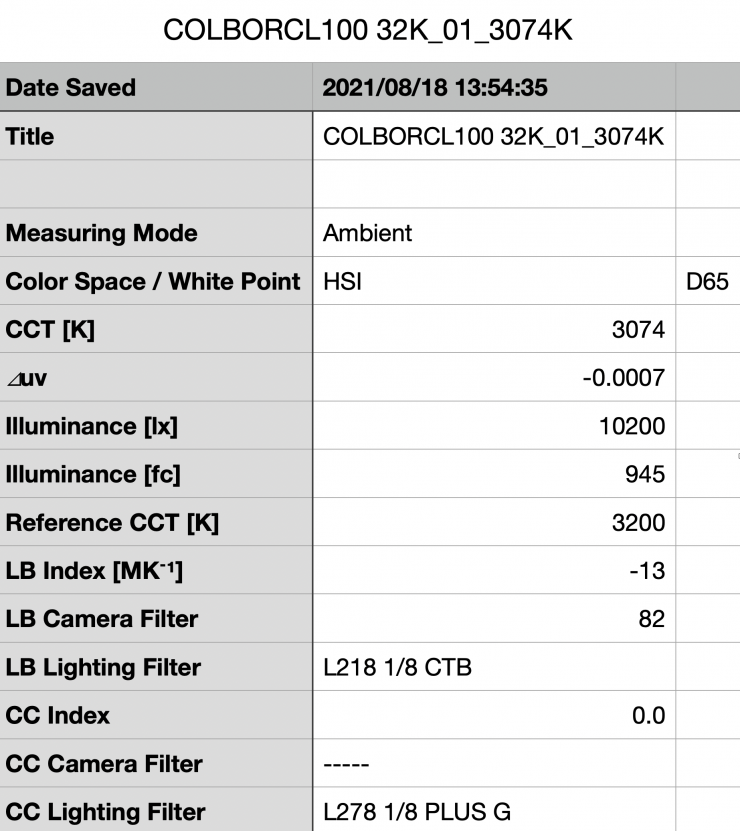
Above you can see the light’s output when it was set at 3200K with the standard reflector was 10200 lx (945fc), this was 19.68% less than what it produced at 5600K.
As a comparison, the Godox ML60Bi LED Light puts out 9360 lx (869 fc) when set at 3200K using the standard reflector. This light only draws 60W. 9360 lx (869 fc)
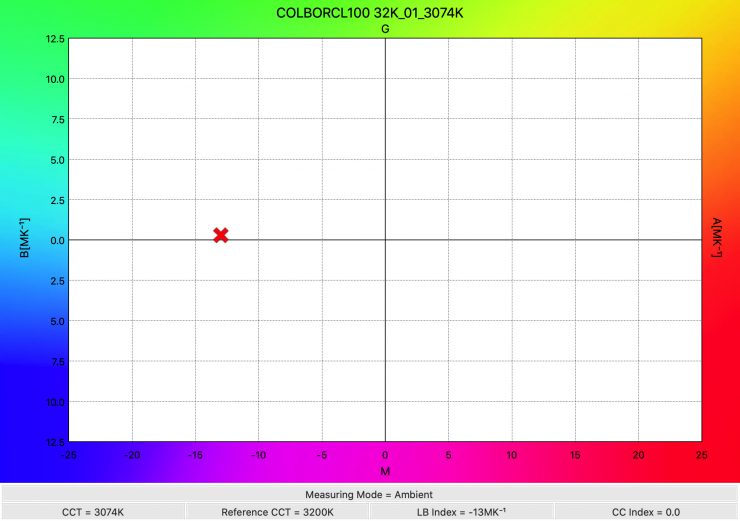
As far as Kelvin color temperature accuracy goes, it recorded a reading of 3074K. Again, just like when it was used at 5600K, the Kelvin color temperature accuracy could be a lot better.
How does the output compare to some of the competition?
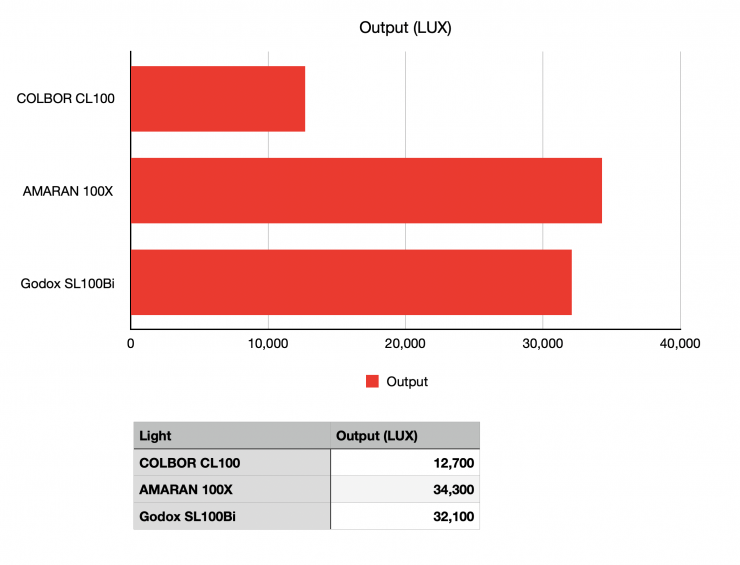
Above you can see a comparison between the COLBOR CL100, AMARAN 100X, and the Godox SL 100BI when they are set at 5600K and using their standard reflectors. As you can see, the COLBOR does not have a high output.
Even the lower 60W power draw Godox ML60Bi LED Light puts out 11400 lx (1060 fc), which is almost as much as the COLBOR CL100.
How does it perform at various Kelvin color temperatures?
Summary of results
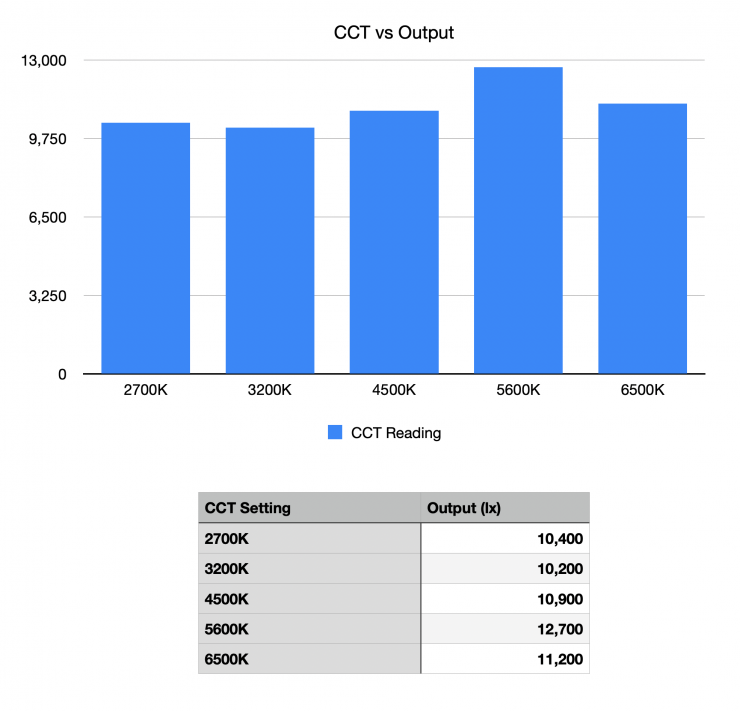
These results show me that the light’s output does vary over its Kelvin color temperature range. It has the most output when used at 5600K and the least amount of output when used at 3200K. The output across the 2800K to 6500K range varies by 19.68%.
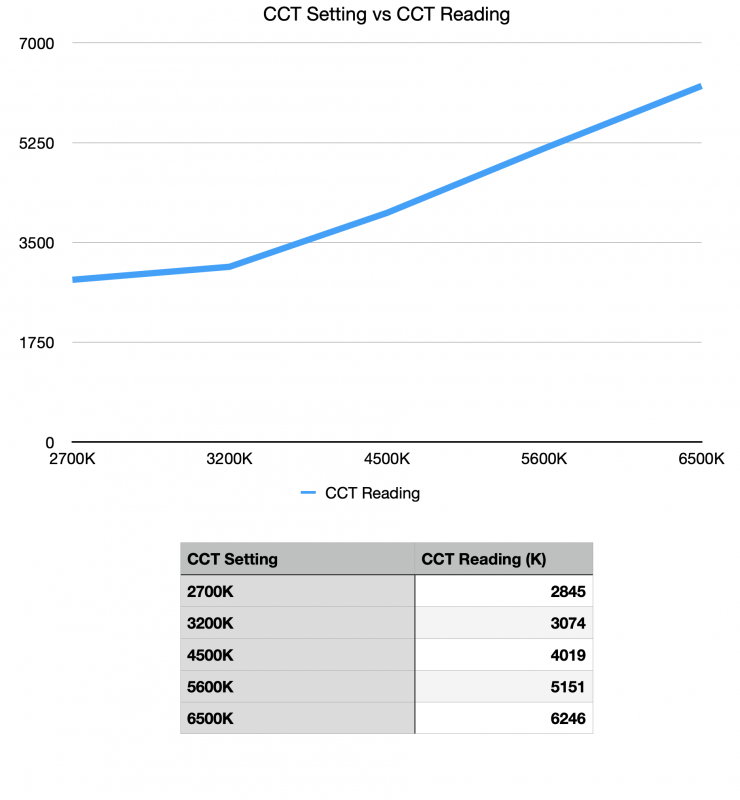
The results also show me that the light is not very accurate when it comes to Kelvin color temperature reproduction from 2700K to 6500K.
Kelvin color consistency when dimming the light
Now, what you should always do when testing lights is to see if the Kelvin color temperature remains consistent when dimming the light. Just because you set a light at say 5600K, that doesn’t mean that the Kelvin color temperature will remain stable as you start dimming the fixture down.
I decided to do a series of tests at 100%/75%/50%/25%/10% to see if the Kelvin color temperature being recorded changed. This was done at a distance of 1m using a Sekonic C-800.
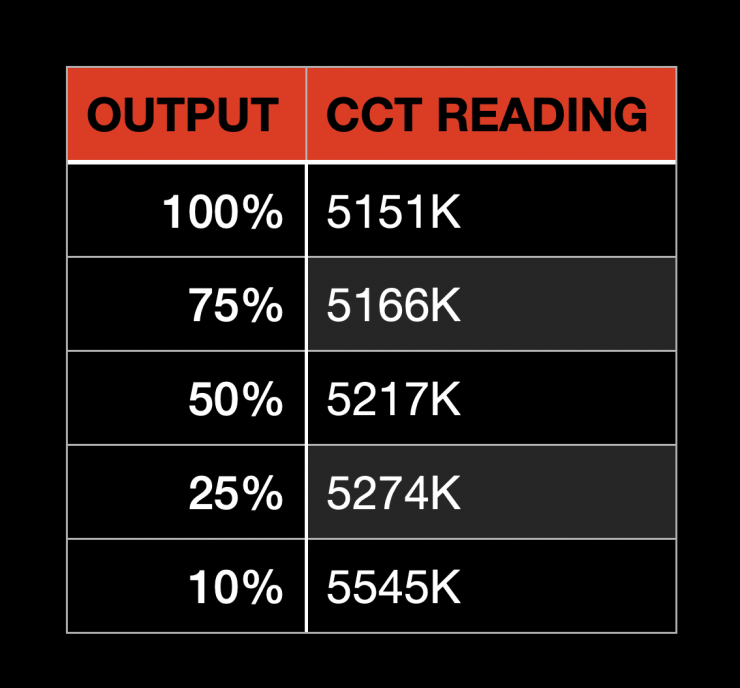
The COLBOR is able to maintain pretty good Kelvin color consistency as you start dimming the fixture. My testing showed that the Kelvin color temperature only varied by 123K from 100% to 25%. These are fairly good results and it shows me that you can dim this fixture down without having to worry about big changes in Kelvin color temperature, except when you go down to 10%.
How linear is the output?
With lights, it is important to check how linear the dimming curve is. So let’s check out how the COLBOR performs.
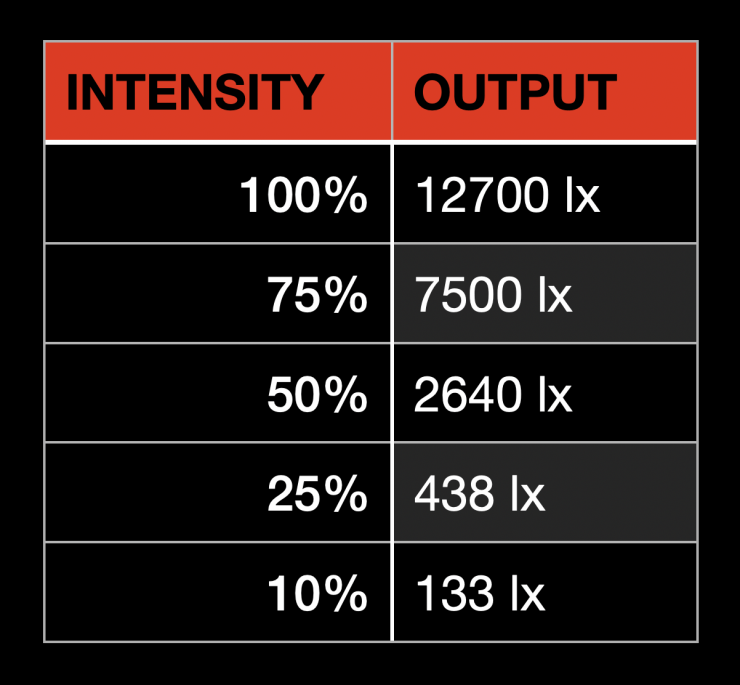
The fixture produces 79% less output when used at 50%. At 25% output, it has 96.5% less output. This tells me that the light’s dimming curve is not in any way linear. This is why we test lights thoroughly, so you know what you are getting when you buy something.
Color Rendering
5600K (standard reflector 55°)
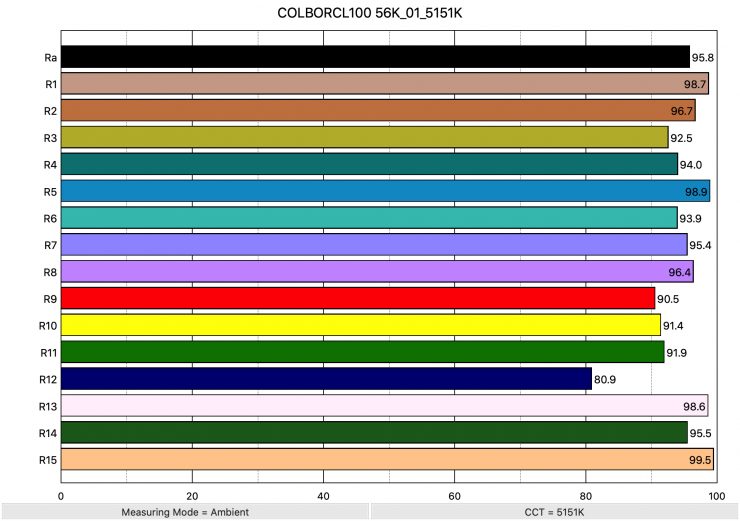
So now that we have seen how much output the CL100 Bi-color produces, how does it perform when it comes to replicating accurate colors. Above you can see that when the light was set at 5600K using the standard reflector it recorded an average CRI (R1-R8) of 95.8 and an extended CRI (R1-R15) of 94.32. For replicating accurate skin tones it recorded for R9 90.5 (red), 98.6 for R13 (closest to caucasian skin tones), and 99.5 for R15 (closest to Asian skin tones). These are all pretty good results.
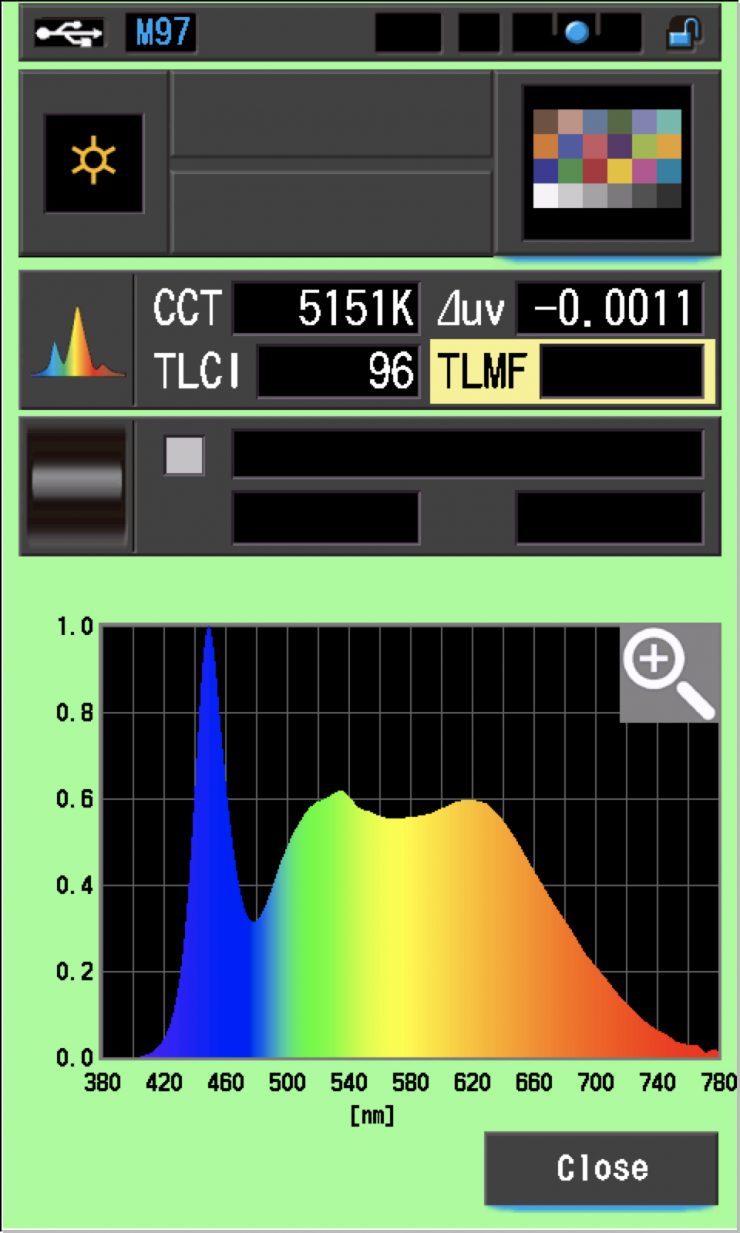
The light, when set at 5600K, recorded a TLCI score of 96.
3200K (standard reflector 55°)
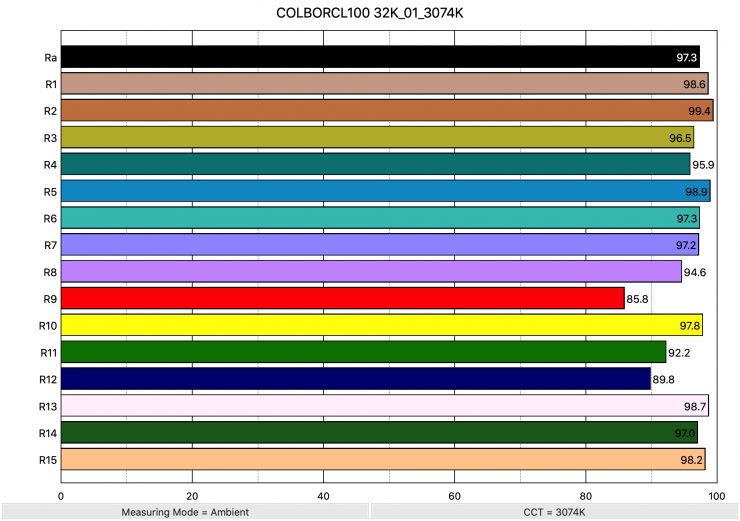
Above you can see the scores for when the light was used at 3200K. It recorded an average CRI (R1-R8) of 97.3 and an extended CRI (R1-R15) of 95.86. For replicating accurate skin tones it recorded 85.8 for R9 (red), 98.7 for R13 (closest to caucasian skin tones), and 98.2 for R15 (closest to Asian skin tones).
These results were fairly comparable to when the light was used at 5600K.
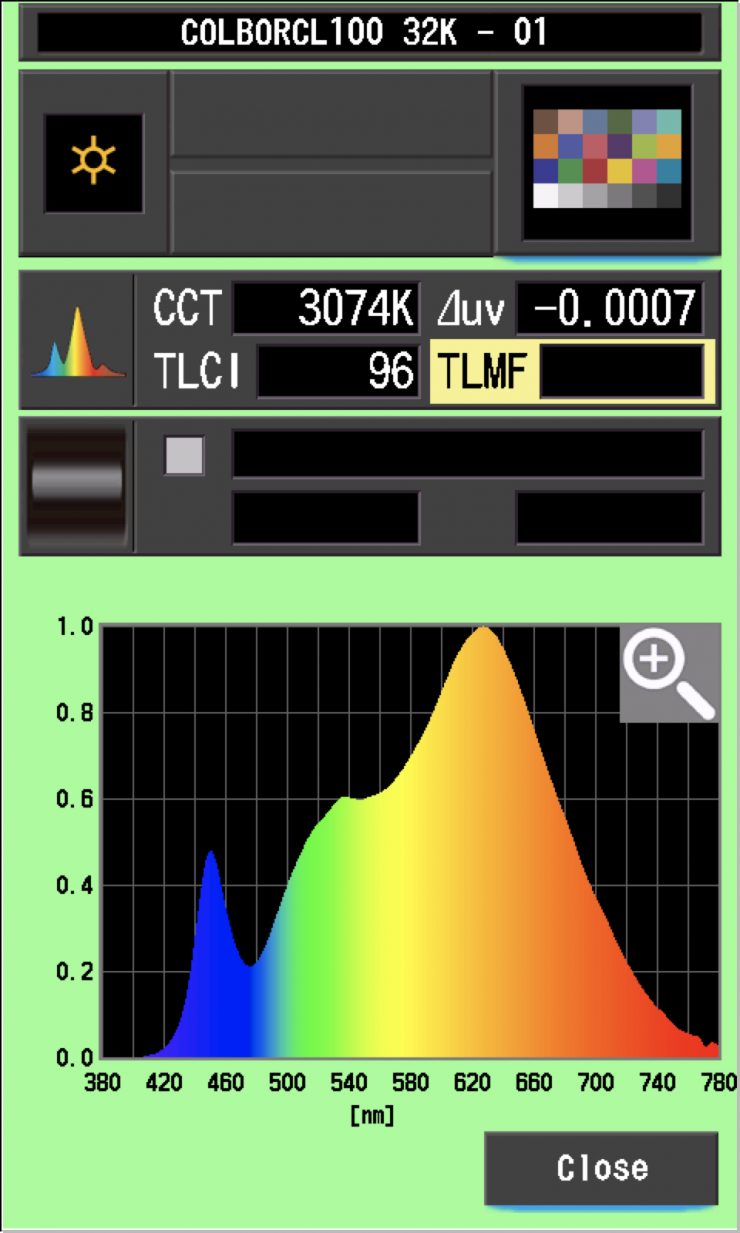
The light, when set at 3200K, recorded a TLCI score of 96.
CC Index & ⊿uv
The CC Index displays the CC correction value and whether any magenta or green need to be added or subtracted. 1 CC corresponds to 035 Kodak CC values or 1/8 Rosco filter values. Any reading less than +1.00 or -1.00 and you’re probably not going to need to make any kind of adjustment. The ⊿uv is the value to show how much this light is away from being an ideal light source (black body radiation = incandescent lamp). As with the CC Index you want this number to theoretically be zero. Kelvin is not a linear value, so we need to convert from Kelvin to MK-1 to compare the values of color temperature. To calculate from Kelvin to Mired is MK-1= 1*1000000/Kelvin. While this may sound confusing, it is the only way of measuring if the Kelvin shift is significant enough to warrant having to use a filter for correction. Below are the results for the COLBOR CL100 Bi-Color:
Kelvin Vs MK-1
| Kelvin | Difference in K | MK-1 | Difference in MK-1 | |
| SET VALUE | 2700K | 0 | 370.37 | 0 |
| ACTUAL READING | 2845K | 145 | 351.49 | 18.88 MK-1 |
| SET VALUE | 3200K | 0 | 312.50 | 0 |
| ACTUAL READING | 3074K | 128 | 325.30 | -12.80 MK-1 |
| SET VALUE | 4500K | 0 | 222.22 | 0 |
| ACTUAL READING | 4019K | 481 | 248.81 | -26.59 MK-1 |
| SET VALUE | 5600K | 0 | 178.57 | 0 |
| ACTUAL READING | 5151K | 349 | 194.13 | -15.56 MK-1 |
| SET VALUE | 6500K | 0 | 153.84 | 0 |
| ACTUAL READING | 6246K | 254 | 160.10 | -6.26 MK-1 |
These figures might look confusing, but what it tells me is that the light is not Kelvin color accurate at almost all temperatures. Any MK-1 score that is under -9/9 means you wouldn’t have to use any color correction gels. The MK-1 scores for this light were the worst I have seen from any light I have tested. Any score where a light is under -/+ 6 MK-1 is considered to be excellent.
Now, again, we need to collect all of the information from all of the tests to be make a comprehensive conclusion.
CC INDEX & ⊿uv
| CC INDEX | ⊿uv | |
| 2700K | 0.2M | 0.0017 |
| 3200K | 0.0 | -0.0007 |
| 4500K | 0.2G | -0.0037 |
| 5600K | 0.1G | -0.0011 |
| 6500K | 0.1G | 0.0010 |
The light is very consistent across the board between its 2700-6500K Kelvin color temperature range. As the light doesn’t feature any +/- G/M correction, it is good to see that it doesn’t lean towards magenta or green in any major way.
TM-30
TM-30 is a relatively new color rendering standard that was developed to deal with the limitations of CRI. TM-30 looks at 99 individual colors. These 99 colors are categorized into seven groups: nature, skin color, textiles, paints, plastics, printed material, and color systems.
TM-30 scores go from 0 – 100. The higher the score, the more accurate a light is at producing colors. Any TM-30 Rf score in the ’90s is considered to be good. What is interesting and something that you need to be very aware of is that two separate light sources with the exact same CRI scores can render colors very differently. A light with a high CRI rating could have a low TM-30 score. Conversely, a light with a good TM-30 score could have a bad CRI score.
Now, there are two measurements associated with TM-30, Rf and Rg.
- Rf (Color Fidelity)
- Rg (Color Gamut)
With Rf value, ideally, you want a score in the 90’s.
With Rg value, a score below 100 indicates that the light source renders colors with less saturation than the reference source. So ideally you want this score to be above 100.
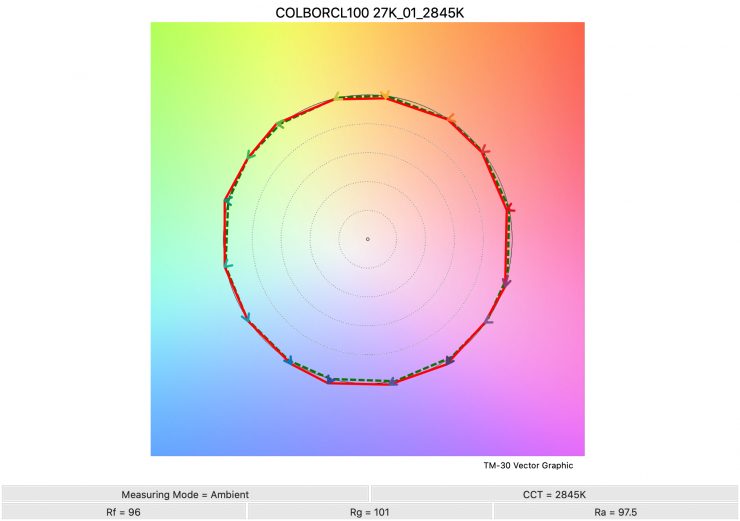
2700K 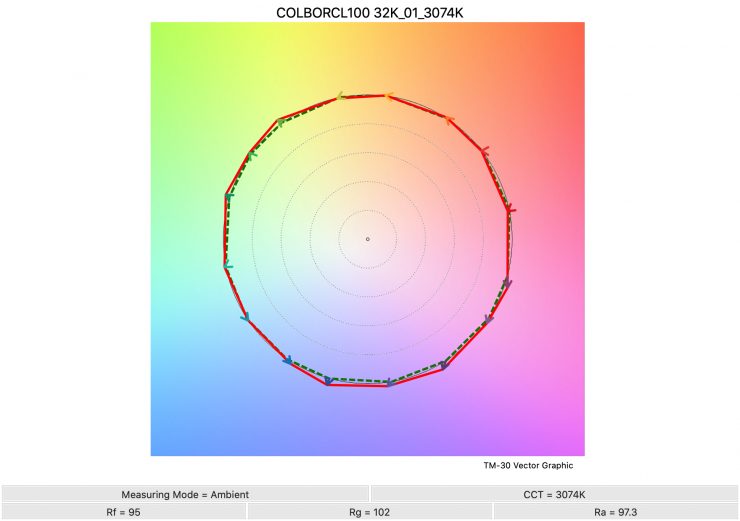
3200K 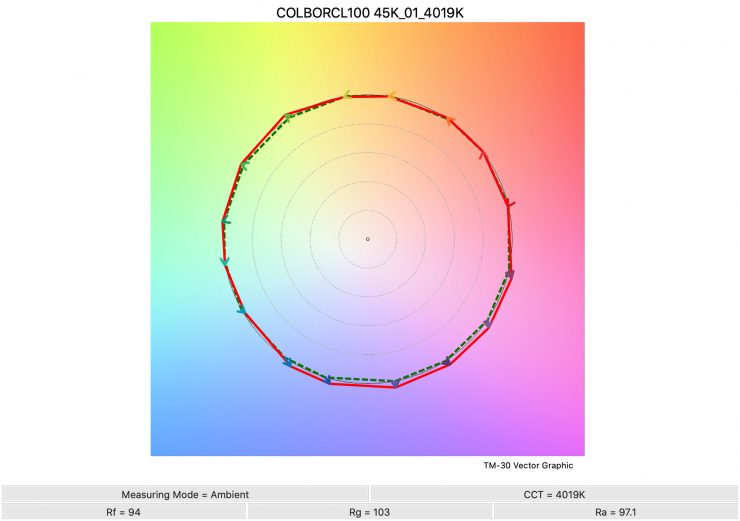
4500K 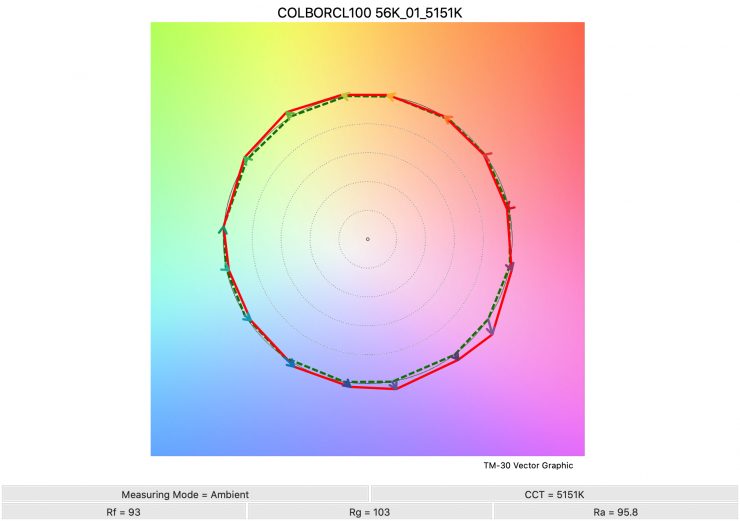
5600K 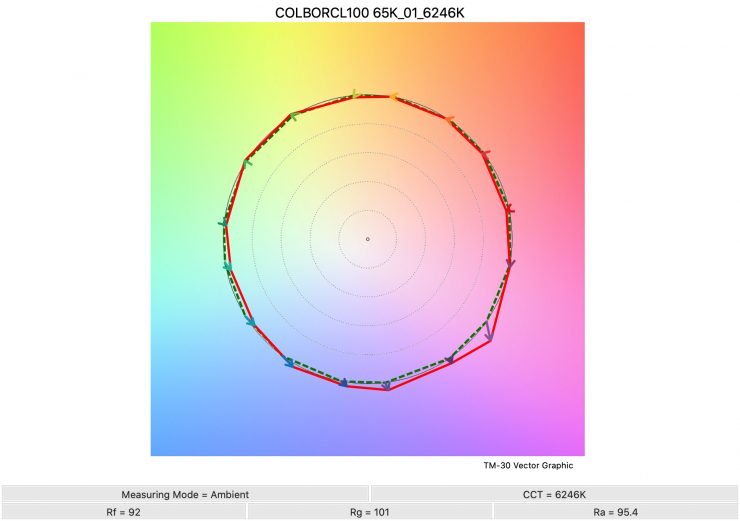
6500K
Above you can see the scores for the COLBOR CL100 Bi-Colorat various Kelvin color temperatures.
Here are the results:
| Rf | Rg | |
| 2700K | 96 | 101 |
| 3200K | 95 | 102 |
| 4500K | 94 | 103 |
| 5600K | 93 | 103 |
| 6500K | 92 | 101 |
These are pretty good results, especially those for Rg.
SSI
SSI (Spectral Similarity Index) was developed by the Sci-Tech Council of the Academy. SSI gives me the ability to set any light as a standard, or use predefined standards (such as CIE D55), and then give other lights an SSI score based upon how well they will match standards such as CIE D55. This way I can measure spectral response and compare it directly against an ideal light source. This is actually a much better test than recording CRI scores.
3200K
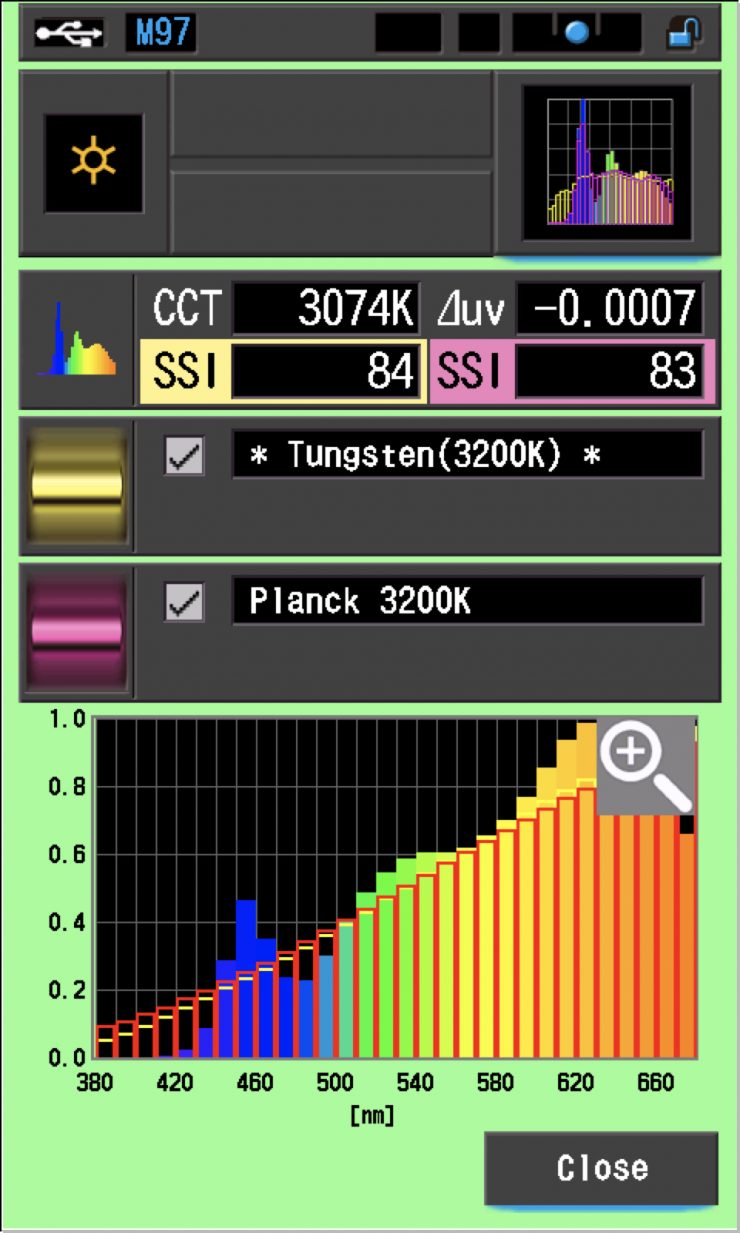
In this graph, the red bars indicate a perfect Planck 3200K source. The gold bars indicate a perfect 3200K Tungsten source. This lets us compare how close to a perfect 3200K lighting source the COLBOR CL100 Bi-Color is. Any SSI score in the high 70’s, low ’80s is very good for a 3200K LED light. As you can see, LED lights have a hard time replicating colors below about 450nm.
5600K
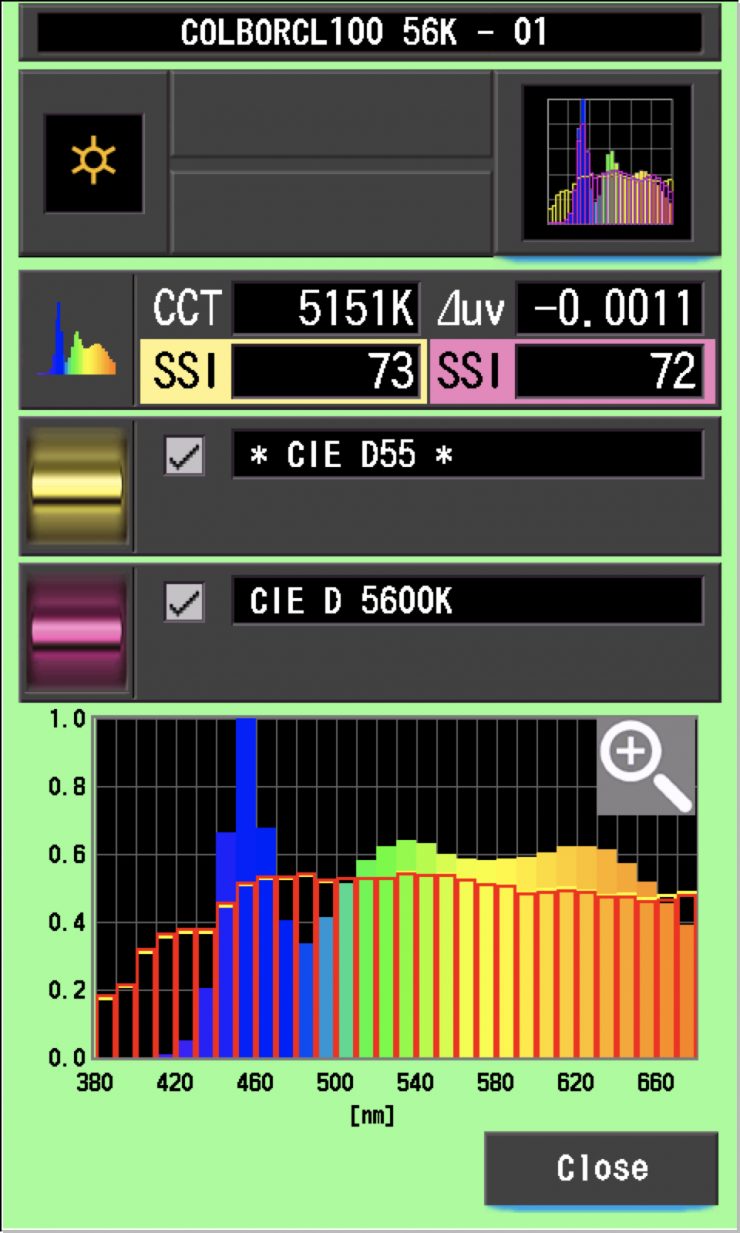
In the graph above the gold bars indicate a perfect CIE D55 source. The red bars indicate a perfect CIE D 5600K source. This lets us compare how close to a perfect 5600K lighting source the COLBOR CL100 Bi-Color is. A score in the low 70’s is typical for a 5600K LED source.
The main reason we want to record SSI scores is so we can see how well they match with other lights. As an example, I wanted to see how well the COLBOR matched the Godox ML60 Bi-Color and the ARRI Orbiter. Below you can see the results.
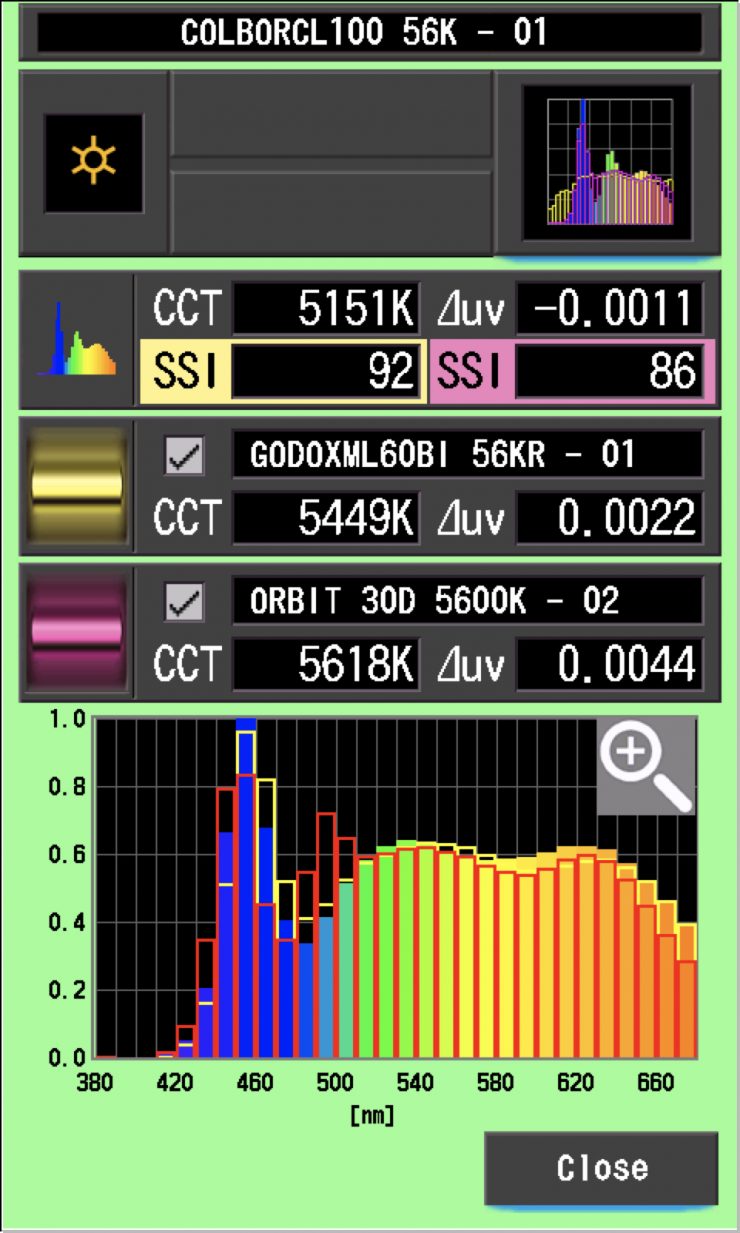
As you can see the COLBOR matches up pretty well to the Godox and the ARRI Orbiter.
So, what about if we use the light at 3290K. Let’s go ahead and compare it to the ARRI Orbiter and the Godox ML60 Bi-Color.
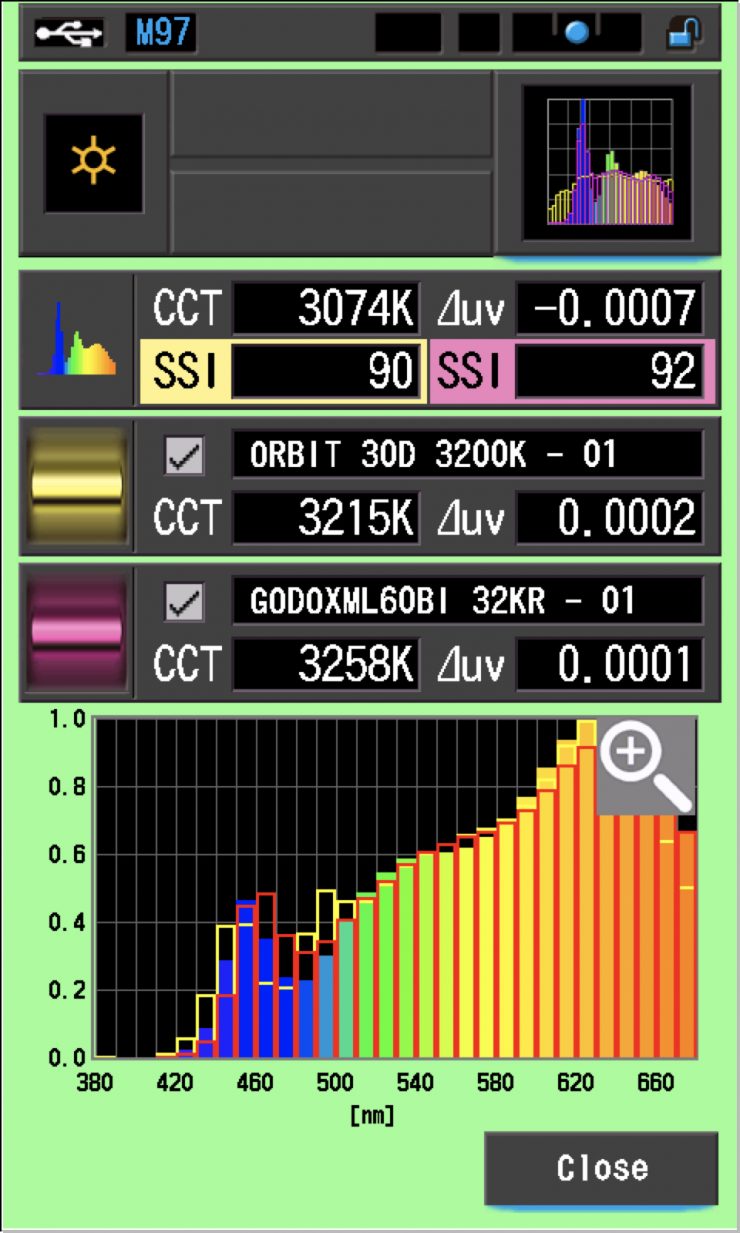
AS you can see, the COLBOR matches well with the Godox and the ARRI.
SSI tests are a great way of telling you what lights you own or use will work well together.
Spectral Distribution
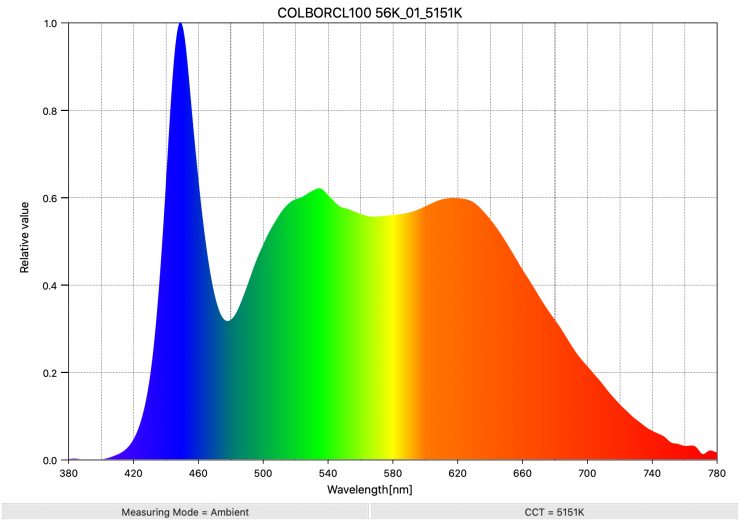
Above you can see the spectral distribution of the COLBOR CL100 Bi-Color when it is set at 5600K. The spectral distribution is reasonably good and there aren’t any big spikes where there shouldn’t be.
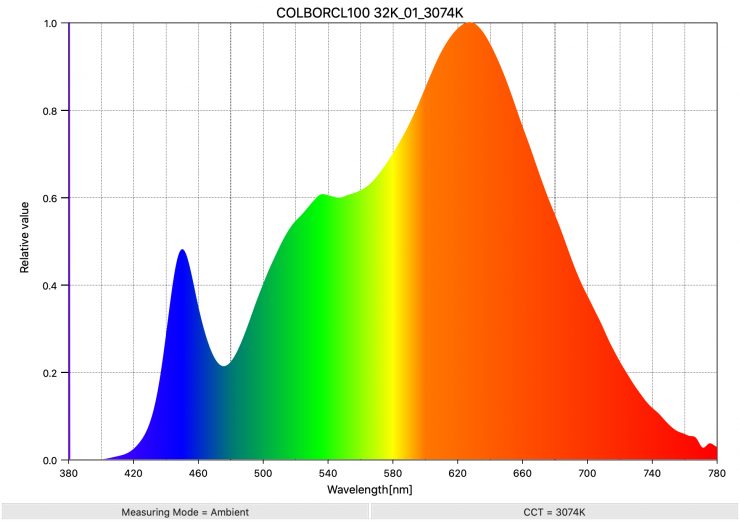
Above you can see the spectral distribution of the COLBOR when it is set at 3200K. Again, just like at 5600K, the spectral distribution is pretty good.
Accessories
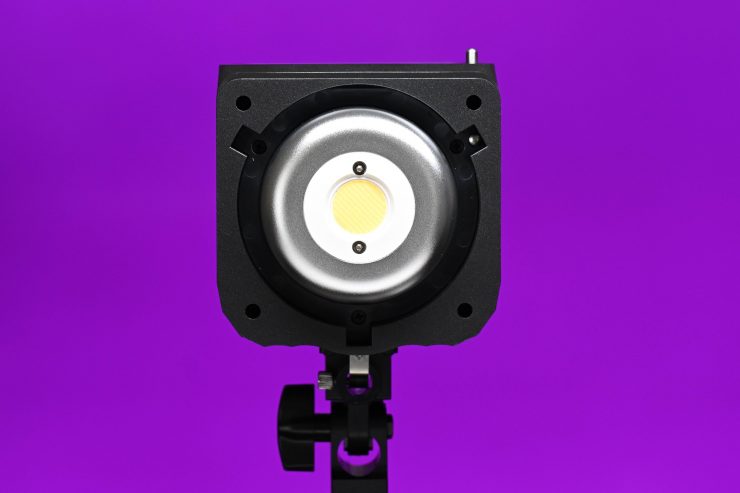
The COLBOR CL100 Bi-Color uses a standard Bowens-S mount so you can use a ton of readily available and affordable lighting modifiers.
Real-World Performance & Quality of Light
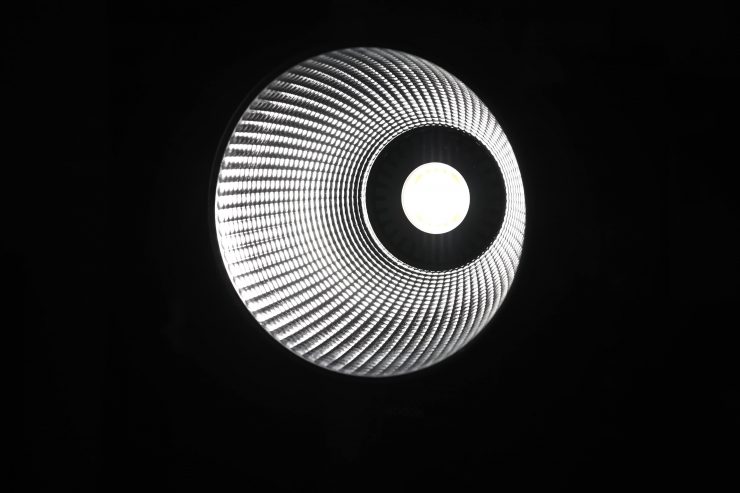
As I always say, photometric scores only tell you part of the story. So let’s find out if the scores from COLBOR CL100 Bi-Color translate into good real-world performance.
The photometric data can only give me scientific data and it is much more important for me to see how the light looks and performs.
Unfortunately, it is very hard at the moment with the Coronavirus for me to showcase the strengths of the light. I live in Japan in an apartment so there isn’t a lot of space to do much testing. I apologize that I can’t do more!
As with all COB fixtures of this type you can’t use them to light up talent unless you are diffusing the light or indirectly bouncing it. This means that they need to have a fair amount of output to start with.
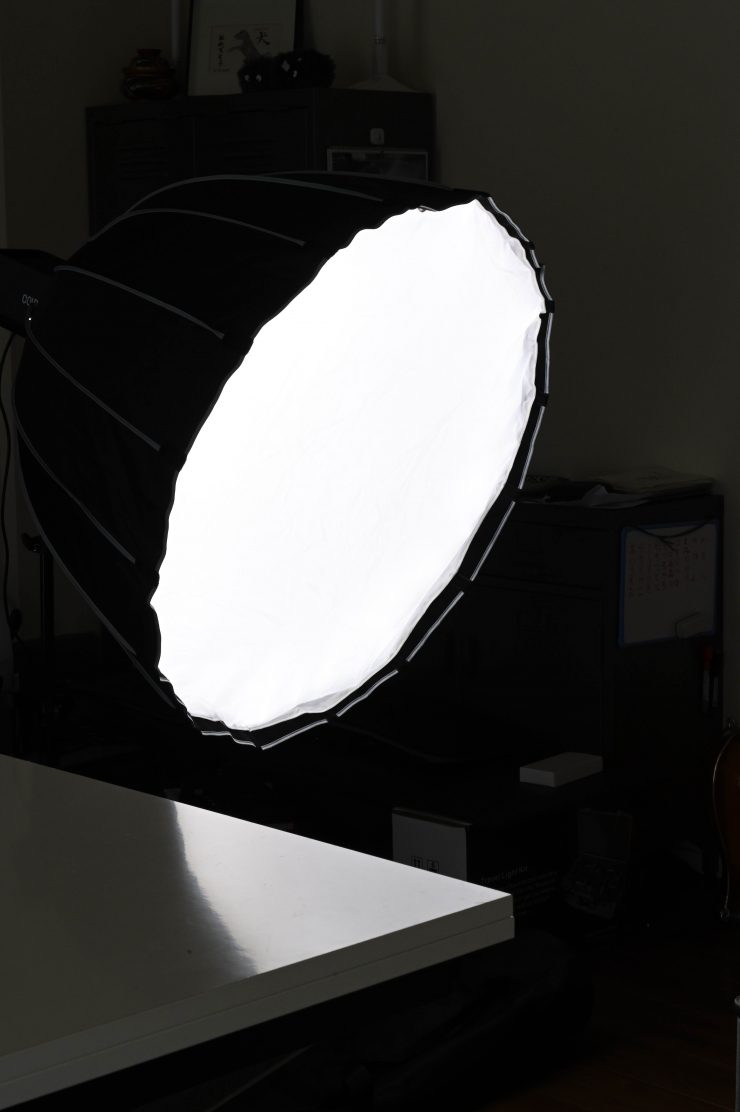
The light certainly works well with a soft box and I found that the CL100 is able to completely fill and illuminate large soft boxes.
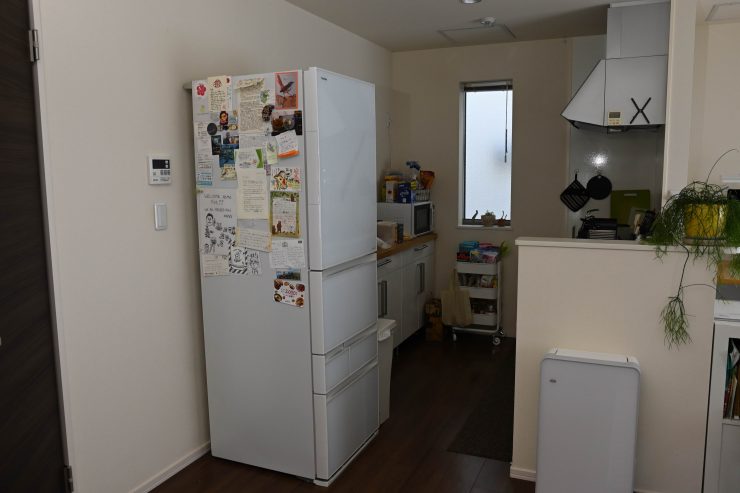
Light at 100% used open face and bounced into the ceiling 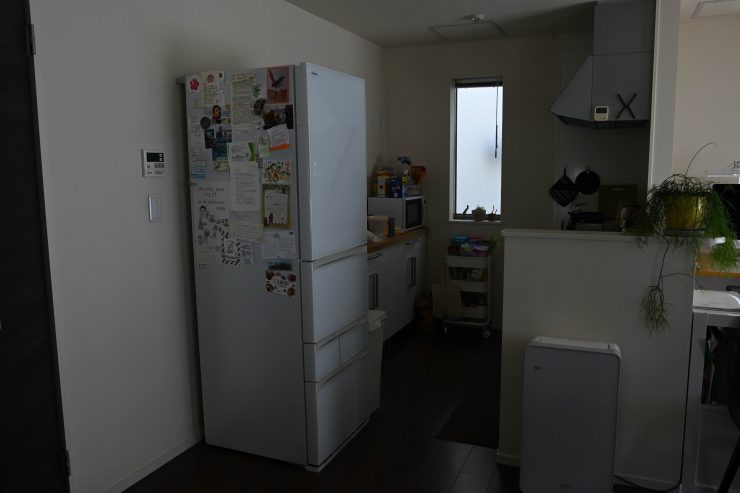
Light Off
If you use the light open face it does have enough punch that you can indirectly point it into a ceiling or wall and can enough illumination to help light up a small room or space.
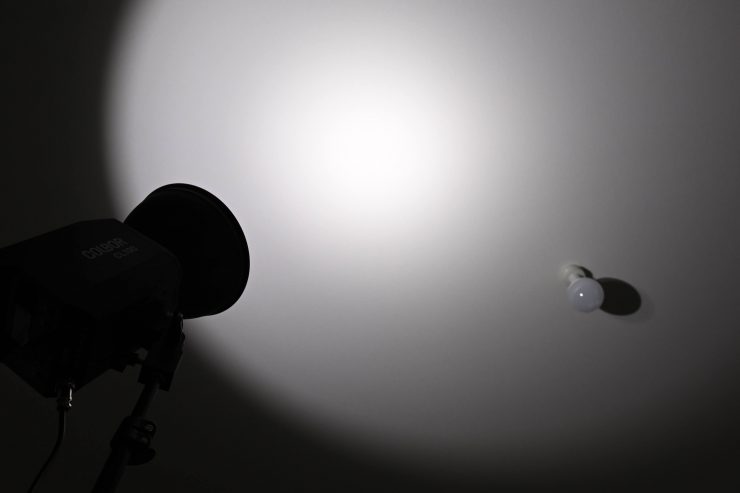
The Standard 55° Reflector does have a hotspot in the middle.
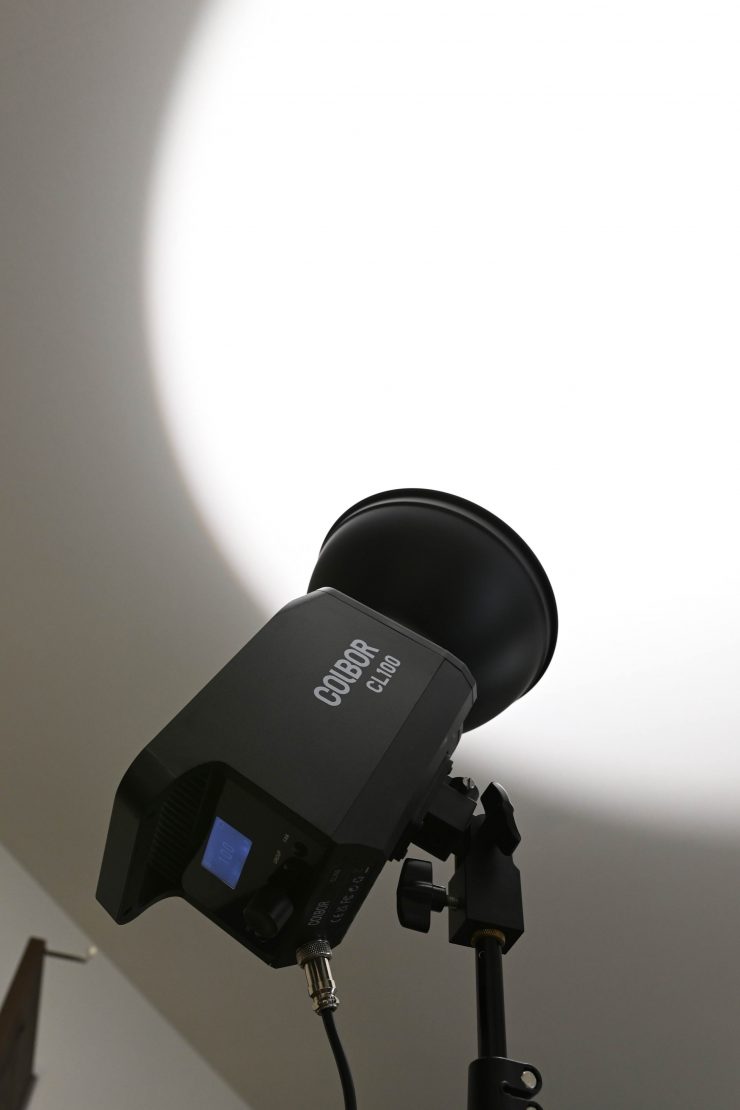
Above is the CL100 bounced indirectly into a ceiling using the standard reflector.

Light at 100% with a softbox at a distance of 1.8m 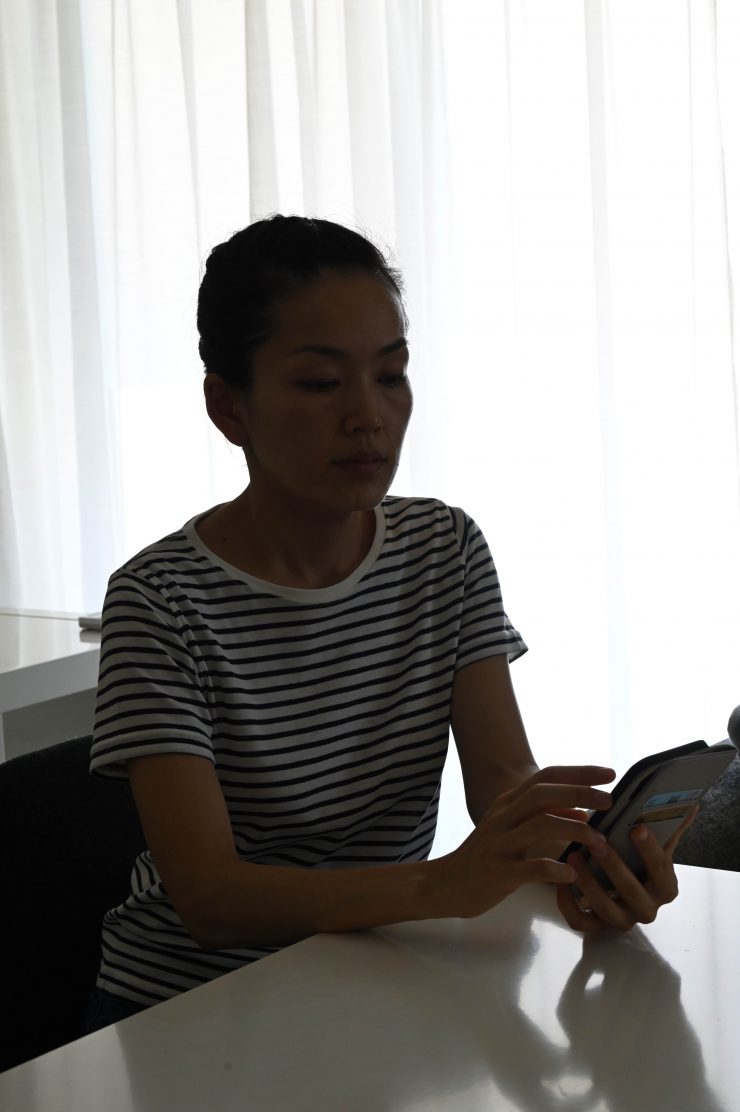
Light off
Above you can see how the light looks with a subject sitting in front of a bright background. Despite not being a super bright fixture, the CL100 has enough output to get the job done. A soft box was attached to the light and it is at a distance of 1.8m from the subject.
At the end of the day, lighting is craft, and someone who knows what they are doing can make any lighting source look good in the right conditions.
Who is the COLBOR CL100 aimed at?
You could use the COLBOR CL100 for lots of different applications, but the light is certainly being aimed at budget-conscious shooters who want a good quality, small-sized, budget-friendly COB fixture.
It is priced to appeal to entry-level content creators and owner-operators who are looking for a small-sized lighting solution that can be run via flight safe batteries that won’t take up a lot of space if you are traveling. By attaching a light modifier such as a soft box, you can create a nice soft light, and conversely, you could use it as a harder source with just the reflector.
The COLBOR is likely to appeal to the same target audience that would be looking at some of the offerings from Aputure and Godox.
Price & Availability
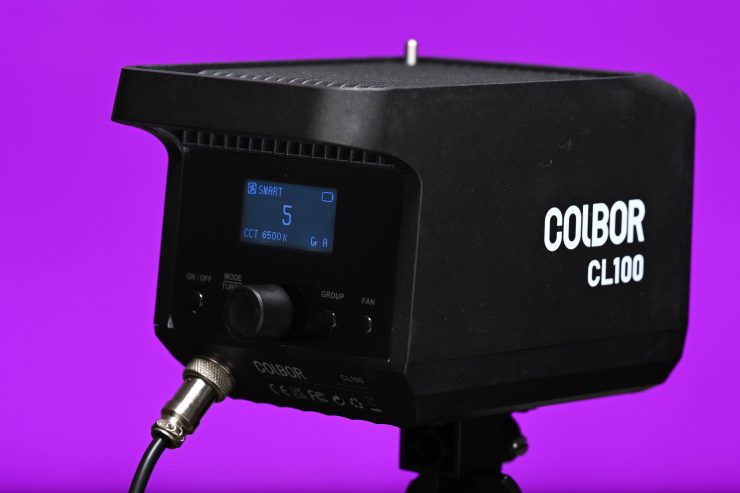
The COLBOR CL100 Bi-Color retails for $199 USD. This makes it a very appealing prospect for those shooters who are not looking to spend a lot of money. The light will beavailable to purchase from the 13th of September at various Amazon stores around the world.
COBOR told me that the optional VBS V-Mount Battery Plate will retail for just $19.90 USD. The problem is, it isn’t available to purchase yet.
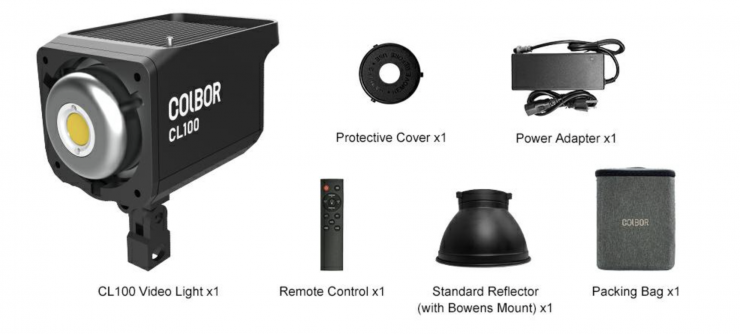
In the box you get:
- 1x CL100
- 1x Protective Cover
- 1x Power Adapter
- 1x Standard Reflector
- 1x Remote Control
- 1x Case
Competition
There are quite a few options if you are looking for a Bi-color 100W COB fixture.
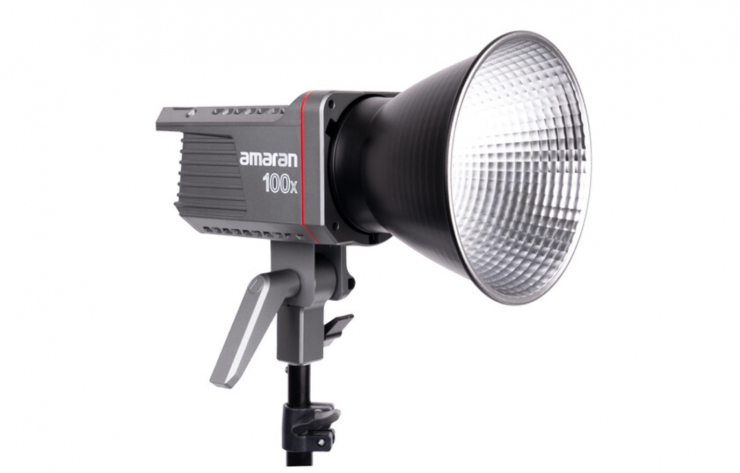
Below you can see how the price compares to some of the other 100W COB Bi-Color LED Lights.
| Price | |
| COLBOR CL100 | $199 USD |
| GVM Bi-Color LED Video Light G100W | $259 USD |
| Amaran 100x Bi-Color LED Light | $249 USD |
| Genaray PortaBright Bi-Color LED Battery-Powered Monolight | $289 USD |
| Godox SL100Bi Bi-Color LED Video Light | $209 USD |
As you can see, the COLBOR CL100 is cheaper than all of these other options, but not by a significant amount.
Conclusion
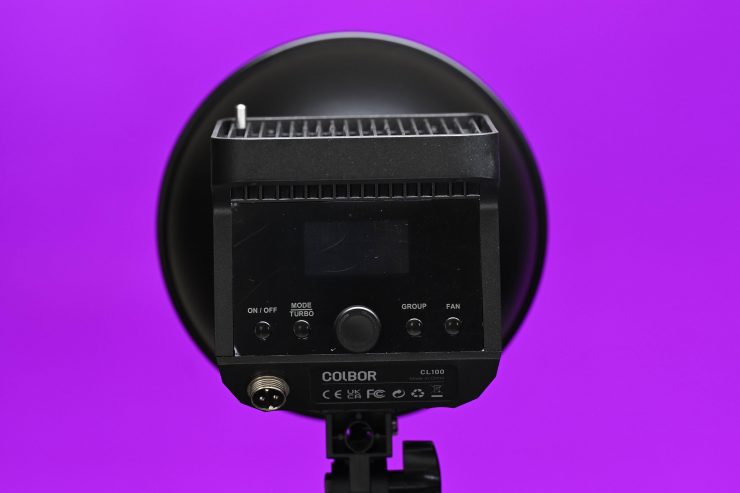
The COLBOR CL100 Bi-Color is a bit of a mixed bag, but despite some of its issues it still represents pretty good value for money.
The biggest problem the COLBOR faces is that it is up against already established lighting brands that cost around the same sort of money. To try and win over potential users you have to either offer features and performance that other similar lights don’t have and/or market your light for significantly less money.
The interface and operating system are reasonably straightforward and easy to use, but the remote controller is overly complicated to pair with the light. The build quality could be better, but it doesn’t get hot and the fan noise is reasonably low. The light is actually very accurate at color reproduction, but it isn’t very Kelvin color accurate. The dimming is not linear in any way and the output is low compared to the competition.
If you want similar output then a light like the Godox ML60Bi probably makes more sense as it is a lot smaller and only draws 60W.
As far as the actual quality of light is concerned, it is pretty good and it is easy to use affordable third-party lighting modifiers.
With a lot of modern LED lights, the quality of the LEDs being used is very similar, even across the price spectrum. What separates the lights comes down to build quality, features, usability, and attention to detail.
You almost always get what you pay for and that is something you have to consider when buying a budget-friendly piece of gear.
The COLBOR certainly isn’t as polished as some other fixtures, but again, this is a light that only costs around $200 USD. The CL100 Bi-Color offers pretty good value for money and it is certainly a good light if you require a portable fixture that can be run off batteries. However, as I have already mentioned, it is going to be hard to convince a potential buyer to choose this over say a Godox or Amaran fixture.
At the end of the day, there is nothing overly special or unique about the COLBOR CL100 Bi-Color, but it does get the job done without emptying your wallet.
If you are just getting into the industry, you are a student, or you simply just don’t have a lot of money to spend on kit, then the COLBOR CL100 is certainly worth having a look at. However, as I have already reiterated multiple times throughout this review, there are other similar products from more established lighting companies that are already available.
Like what we do and want to support Newsshooter? Consider becoming a Patreon supporter and help us to continue being the best source of news and reviews for professional tools for the independent filmmaker.

